2 Days in Amsterdam: Amazing Itinerary for First Timers
Amsterdam was a city that I – Matt here! – had never really figured out until a recent 10 day stay when I finally was able to wrap my head around the unique history and culture that has been cultivated in the Dutch capital over its more than 1,000 years of existence.
It’s something I always forget, because I’ve spent a lot more time in France, Spain, and Italy over the past five years or so (countries that also have fascinating historical and cultural elements), but the Dutch were a MAJOR player in world trade in the 16th and 17th Century.
In fact, there’s an entire Dutch Golden Age that refers to that period, when Amsterdam was at its peak and was one of the wealthiest places in the world at the time (certainly in Europe).
Unfortunately, a lot of that rich history gets completely lost when you talk about Amsterdam today with just about everyone.
Over the past several decades, Amsterdam has cultivated a reputation for being one of the party capitals of Europe, driven partially by its lax treatment of certain drugs (a reputation it is now frantically backpedaling away from).
That treatment of certain substances is emblematic of the broader idea of tolerance that makes Amsterdam special, even to this day. A tolerance that let to, in one case, a relatively large Jewish population settling in Amsterdam after fleeing persecution in Spain, Portugal, and eastern Europe.
However, that context gets completely passed over when (mostly older Americans) say things like “oh, going to party hard, huh?” when I told them I was spending more than a week in Amsterdam.
For the record, anyone that knows me would absolutely know that I value my 9pm bedtime FAR too much to be out partying late into the night.
Anyway, the point is that Amsterdam is so, so much more than a party destination, and my intent in writing this guide is to highlight those aspects of the city.
In this guide, we’re going to give you a 2 day itinerary for Amsterdam that is informed by our own experiences exploring the city over multiple different trips (a few different trips several years ago, one 10 day trip more recently).
We’ll start with some logistics – like where to stay and how to get around – and then get into a specific itinerary for spending 2 days in Amsterdam.
Our intention is to give you all the information you need to put together your own itinerary, and along the way help you discover a few places or experiences that we loved and think you will too.
Sound good to you? Let’s get into it!
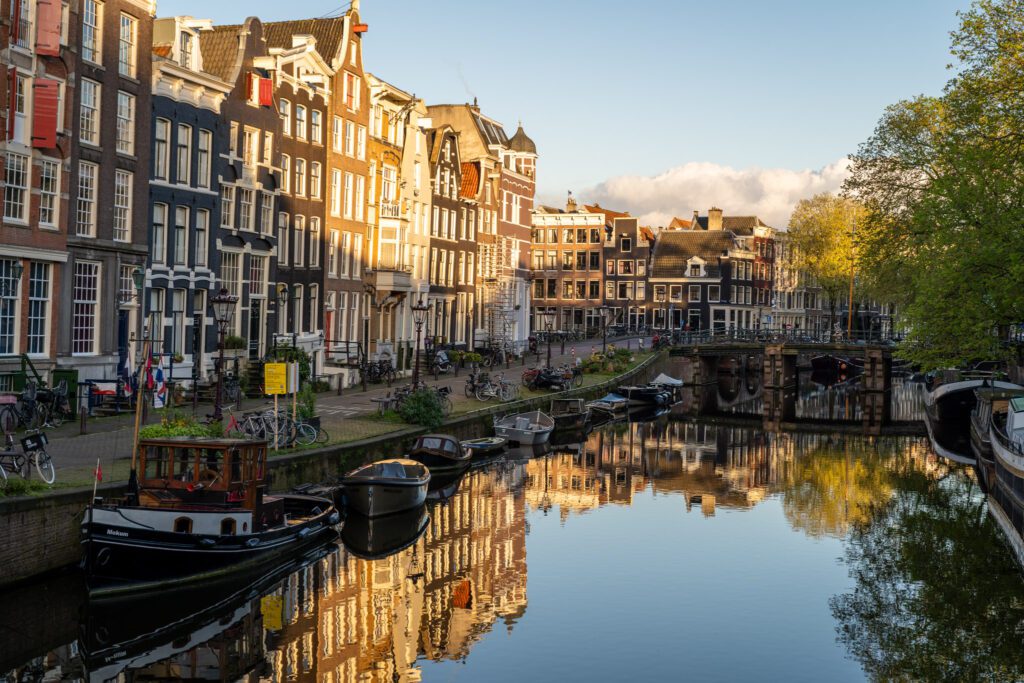
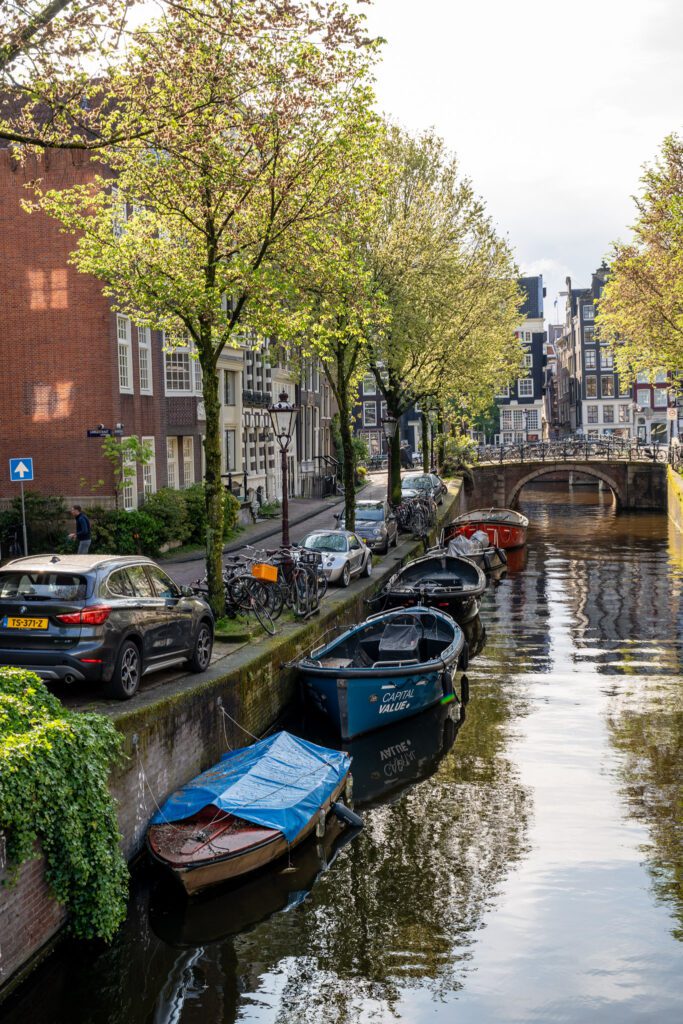
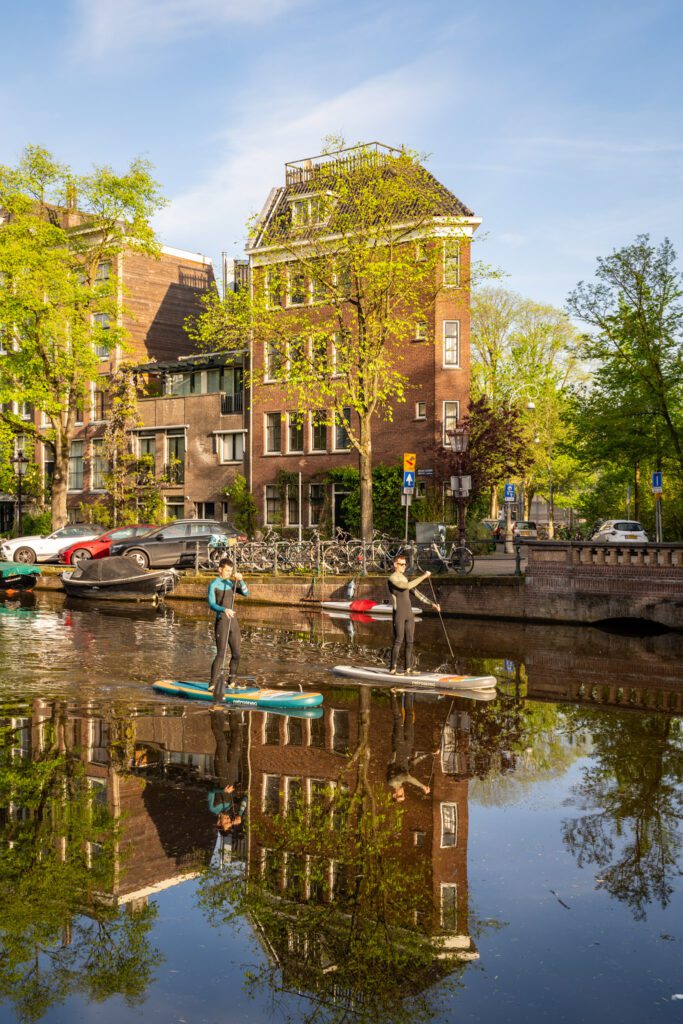
Disclaimer: Some of the links in this post, like hotel links, are affiliate links, meaning at no additional cost to you, we make a little bit of money if you click through and book. That being said, we would never recommend something to you that we don’t stand behind 100%.
How Much Time to Spend in Amsterdam
Overall, we think you need at least two days to see the highlights of Amsterdam itself.
Two days allows you enough time to get a feeling for the city, see the highlights, tackle one of the two major museums in the city, and eat some good food.
However, two days is really short-changing Amsterdam, and I know that because I spent two days in the city TWICE in two years, and still only really scratched the surface.
It wasn’t until spending 10 days in the city recently that I really started to get a feel for what Amsterdam was all about (and even then I still didn’t make it out to the day trips I had wanted to do because there’s so much to see within Amsterdam’s city limits!).
A third day would be better if you wanted to do both of the major museums (the Rijksmuseum and the Van Gogh Museum) and have a generally more relaxing experience, or if you wanted to add a day trip to one of the nearby cities in the Netherlands.
One day just isn’t really enough time, and we’d strongly recommend adding a second day to your trip if you can swing it (I can’t bold the word strongly enough here).
Where to Stay in Amsterdam
First things first, we need to talk briefly about Amsterdam’s geography in order to get you oriented and understand what we’re talking about (we also have a whole guide dedicated to choosing a place to stay in Amsterdam, which has far more detail than what we have here).
Amsterdam’s historic center is on the IJ River, with the main train station sitting right next to the river, and fans out to the south from there.
It’s like a half of an onion, which is a point that Anna, my guide for the walking tour I did to kick off my trip, made and I told her I was unapologetically going to steal that description.
The interior piece of the city is ringed by canals, called the Grachtengordel (which were an extension of the old city built in the 16th and 17th Centuries), and when you get to Museumplein, the onion ends and it becomes much more urban and well-planned.
We don’t think you should stay anywhere in the area immediately surrounding Amsterdam Centraal. It’s the least interesting part of the city for us, full of chain restaurants and higher prices.
While it’s convenient in terms of getting to the train station, Amsterdam’s great public transportation means that it’s not as important to be within walking distance to the train station.
Instead, we’d head south and stay at the far end of the “onion”, which is our favorite part of the city and brings you to a bit of a decision point.
That decision point essentially comes down to budget and what kind of experience you’re looking for.
Grachtengordel: The Canal Belt, aka the Best Part of Amsterdam
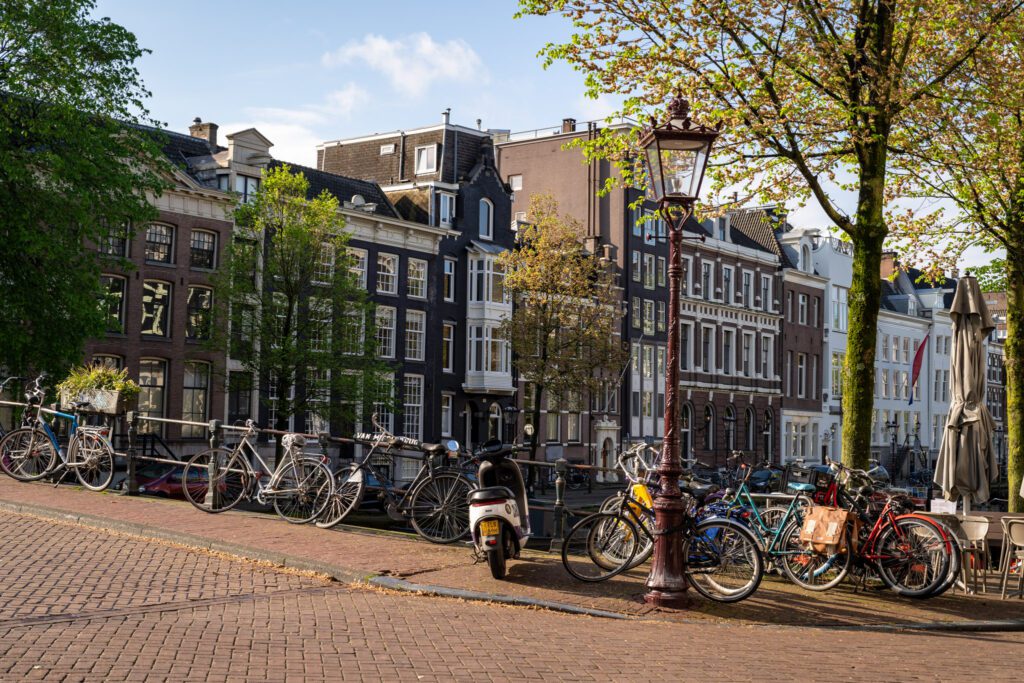
The canals are our favorite part of Amsterdam – particularly a walk along the canals either early in the morning or late at night when they’re quiet and peaceful – but the problem with an old city built on a swamp that has been designated a UNESCO World Heritage site is that development is tough.
The result is that there are only a few hotels along the canals, and they’re all pretty expensive.
At a high level, the Grachtengordel refers to the three (or four, depending on the source) interior canals that were built as an initial expansion to the old town, which was centered around Dam Square and the Red Light District.
Our favorite part of the broader neighborhood is the 9 Straatjes – a sub-neighborhood that refers to a three block by three block section right in the middle that offers some of the most scenic sections of canal that exist in the city.
Like we mentioned, this is the most expensive part of Amsterdam to stay in, and the hotels here definitely lean in that direction. This is NOT the place to stay if you’re on a budget.
In terms of hotels, you only have a few options in the best part of the Canal Belt.
The Ambassade Hotel is the best value of the bunch, with the Hoxton and the Noblemen being two other good options in the best part of the neighborhood.
For what it’s worth, we also really like nearby Jordaan, the heavily gentrified former working class part of the city, which also doesn’t have many hotel options to speak of aside from Morgan & Mees, where Matt was planning to stay (and even had a room booked) before deciding halfway through his trip that he wanted an apartment because living out of a hotel room for long stretches can get old fast.
Museumplein: A More Budget-Friendly, Equally Convenient Alternative
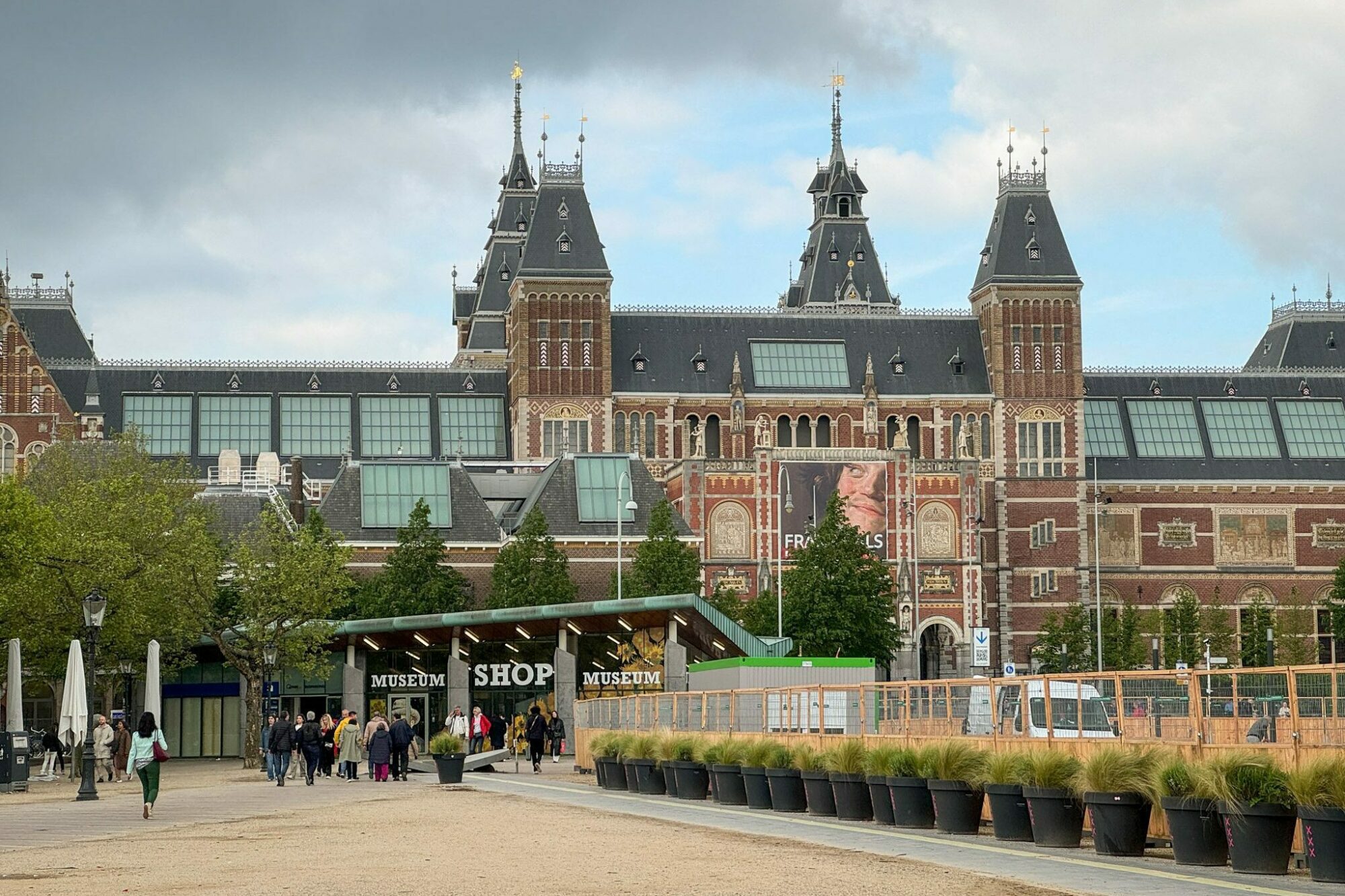
Your other option is the area around Museumplein, which is where we stayed on our last trip. You can either stay in the neighborhood immediately adjacent to Museumplein, or in the neighborhoods adjacent to it (Oud-Zuid).
On my last visit, I (Matt here) stayed at Jan Luyken, a charming boutique hotel in a historic townhouse a block from the Rijksmuseum, and cannot recommend it more highly.
It’s stylish and comfortable, but the best part is the fact that literally everything – breakfast, wine, beer, and spirits, snacks, the gym, and more – is included in the rate.
So you don’t feel like you’re getting nickel and dimed at every turn.
A Note on Airbnb in Amsterdam
The other thing to note about Amsterdam is that Airbnb is HEAVILY regulated here. To the point that it basically doesn’t make sense to use it (which is exactly what they were going for).
At a high level, you can only rent a place where the host is actively living if the stay is less than 30 days, which means full apartment rentals are non-existent for short trips. It’s mostly rooms for rent, which is what Airbnb was supposed to be anyway.
I actually met two separate people on my last trip who had nightmare Airbnb stories in Amsterdam, including someone who told the guests to pretend they were family to avoid a fine and someone who canceled the stay during their flight to Amsterdam, which they found out about when they landed.
If you’re looking for an apartment for your stay, we’ve been loving aparthotels on our travels, which just means it’s a hotel – there’s a front desk and other amenities you’d expect from a hotel – but the rooms are apartments often with more space and full kitchens.
There are two great aparthotels that I came across and decided between that are a few blocks from each other in Oost.
I landed on Wittenburg by Cove, which is a company I’ve stayed with in London and loved, and the apartment was excellent.
Good location, comfortable space, full kitchen, and great building amenities. However, there is a minimum stay of 7 days.
Zoku is a more social option, and almost borders on a high-end hostel where the rooms are studios with kitchens and workspaces (it’s marketed towards digital nomads and business travelers) with lots of common space throughout the building.
A Perfect 2 Day Amsterdam Itinerary for First Timers
And now, let’s get into the meat of this itinerary.
We have a secret for you. And it’s a lesson that it took us years of traveling to finally learn on our three month European extravaganza a few years ago (if you don’t know our story, you can read it here).
Travel is better – and by better, we mean more rewarding, interesting, and fun – when you try your best to connect with locals to see the place through their eyes.
I (Matt here!) took that to heart on my last visit to Amsterdam in an effort to better understand what makes the city special, and came away with a much richer understanding of Amsterdam’s unique culture and point of view on life.
Particularly on that latest trip, I did a bunch of different tours and experiences (I’ve included the ones that I thought were particularly special in the guide below) that opened my eyes to a new side of the city, culture, and people.
Our biggest tip for Amsterdam (or any city, really) is to prioritize tours that connect you with locals and allow you to get a unique perspective on the city (which is what you’re going to see in this itinerary).
In terms of structure, we always do our best to anchor the days in our itineraries around a main experience, with time on either side for things like coffee, cocktails, and good old fashioned wandering around a neighborhood.
And we never, ever do multiple museums in a single day. Trust us and learn from our mistakes – you WILL be exhausted by the time you get to the second one, and will get a lot less out of it.
Here’s an overview of the itinerary you’ll find below:
- Day 1: Orientation to Amsterdam, a Museum, and the Canal Belt
- Day 2: The Jordaan, Anne Frank House, and De Pijp
Day 1: Orientation to Amsterdam, a Museum, and the Canal Belt
On your first day in Amsterdam, spend your morning getting oriented to the city with a canal cruise (or walking tour, depending on what sounds good to you) and then choose one of the two major museums to focus on before ending your day with a wander along the Canal Belt and an Indonesian feast.
Get Oriented to the City (and Chat with a Local)
Walking tours are our favorite way to get oriented in a new city for a few reasons.
First, you get a crash course in history and culture, which is a valuable baseline that will make the rest of your trip more enjoyable.
Second, you get to spend a few hours with a local who will give you all sorts of tips about what to eat, drink (and see), and specifically where to find the best version of said things.
Last, but not least you’ll discover places that you definitely would never have found on your own.
We always do a walking tour on our first day in a city, and Amsterdam was no different.
However, after doing an early morning canal cruise, we actually think that’s a good alternative given the important role of the canals in Amsterdam’s history.
A Canal Cruise (with Captain Dave!)
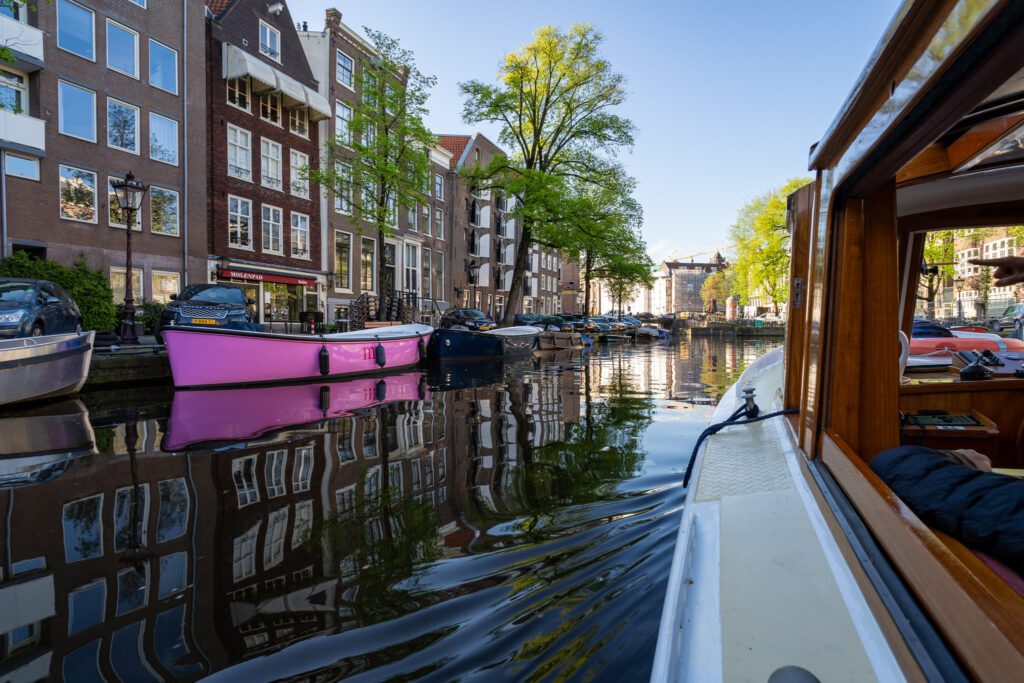
The first thing you should know is that I was extremely skeptical of the canal cruises based on seeing a steady stream of them full of tourists throughout the day.
However, after getting recommendations from multiple local Amsterdamers to do one to see the city from a different perspective, I decided to find one.
I was looking for two things; an early morning offer (that’s the best light and quietest time of day) and a small boat.
I found Captain Dave’s canal cruise, which is a small historic boat that hits the canal at 8am, and I could not have been more happy with it.
We were the only boat on the canals when we were out there, and Captain Dave was a very charming host who gave us a geography and history lesson as we meandered along the canals bathed in the early morning light.
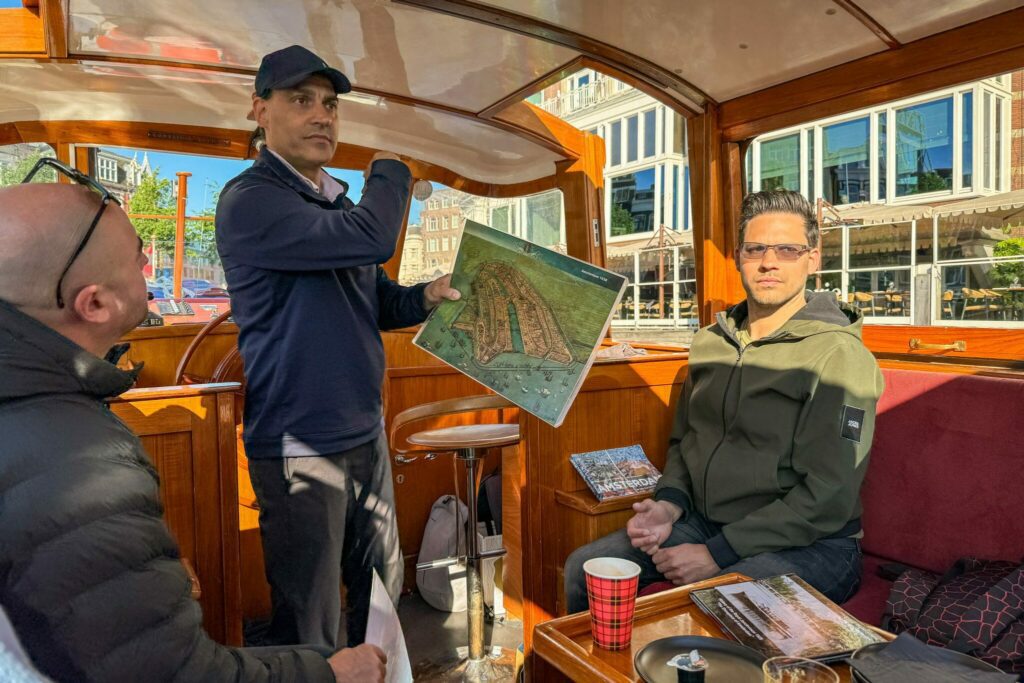
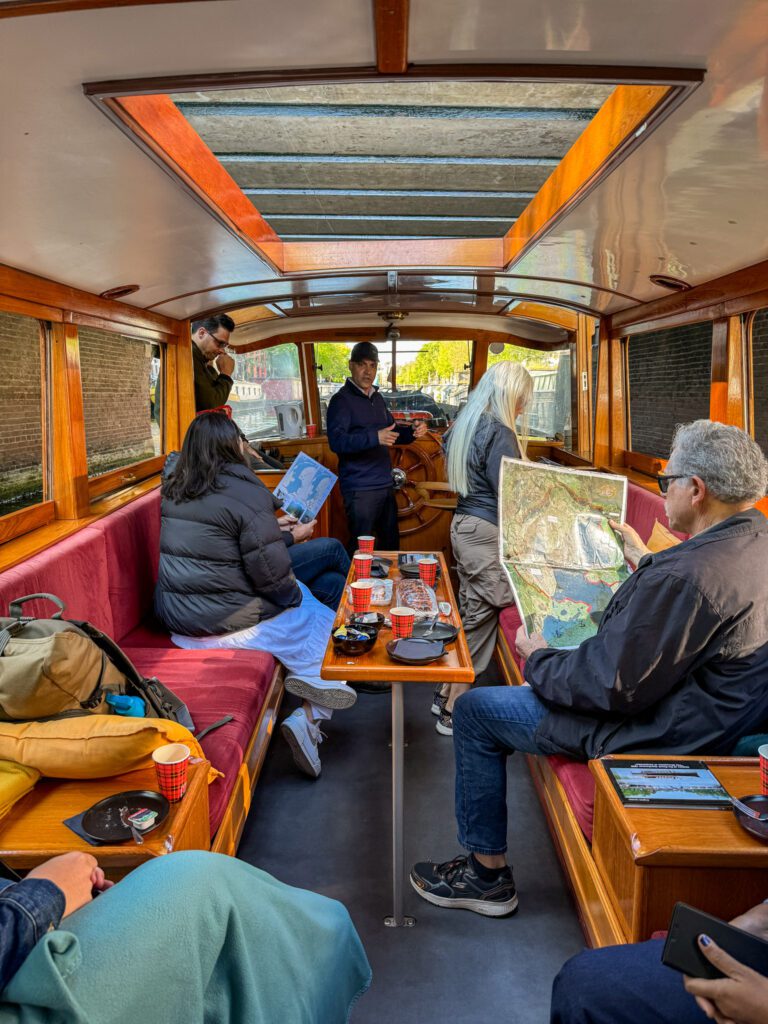
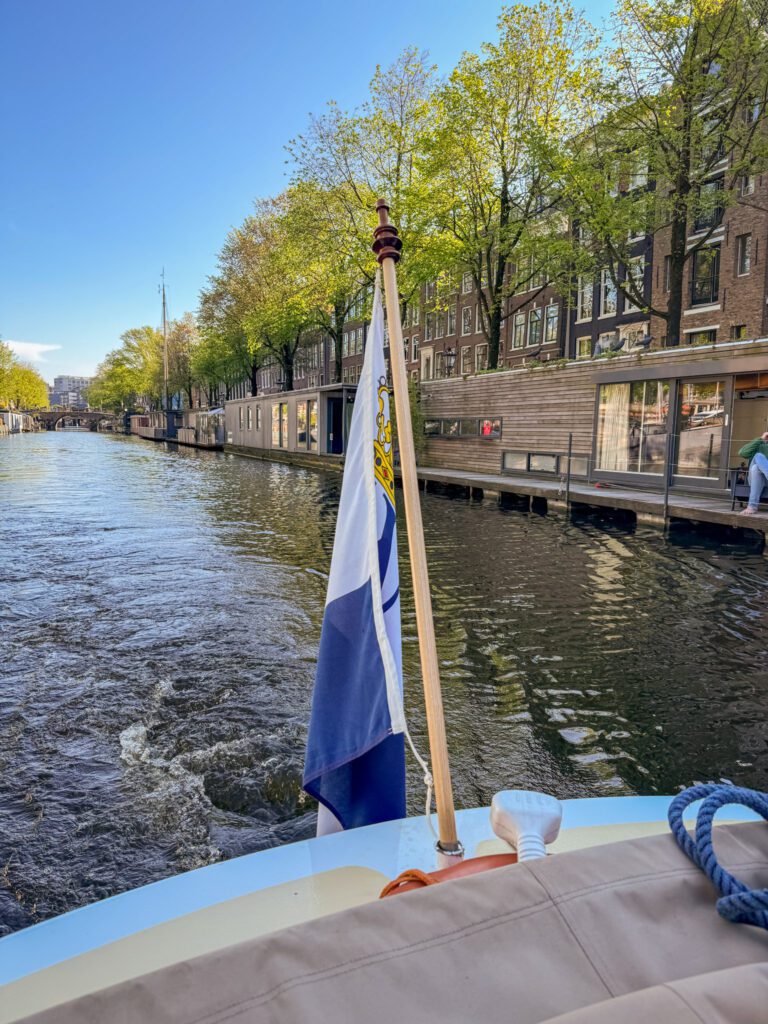
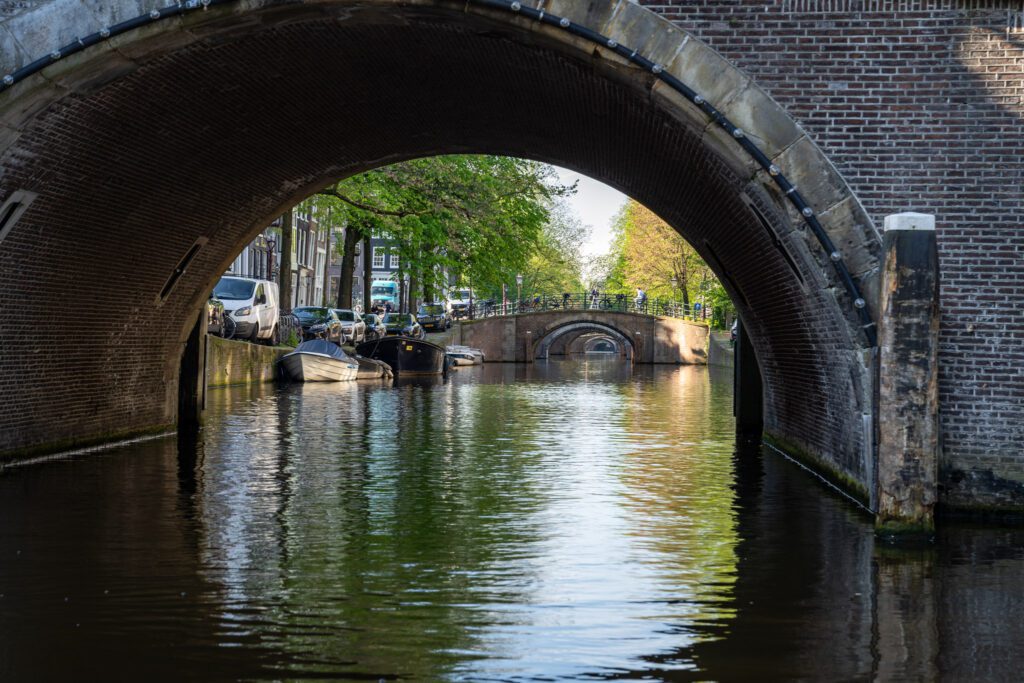
Given the importance of water (and the canals) in Amsterdam’s history, I think this is a unique way to get oriented to the city, and I would highly recommend it (even in place of a walking tour if you have limited time, which is saying something because we LOVE walking tours!).
A Walking Tour
I did multiple different walking tours on my latest trip to Amsterdam – I was trying to understand Amsterdam’s history and, rather than consulting Wikipedia, I decided to hear it from a local – and there were two that really stood out to me as being great introductions to the city.
First is the Highlights and Hidden Gems tour I did with With Locals, a tour company that I’ve come to really enjoy over the past few years after our first tour in Lisbon was a hit with our entire group (Matt’s brothers were with us).
The thing we like about With Locals is the fact that it’s a private tour – which means it’s entirely customizable to your interests – AND you get to choose your guide.
Given the fact that the guide is basically the most important part of any tour, this is an important feature for us (and you can make sure to choose an actual local!).
The other option – and this might be one of the most unique walking tours I’ve ever done in all of my travels – was the Humans of Amsterdam walking tour that I did on my last day.
It’s a four hour dive into the culture and history of Amsterdam that involves multiple food and drink stops, and two stops where you get to meet a local and chat about their life in Amsterdam and ask questions, which is fairly unique.
It’s a long tour and it’s more expensive than your generic walking tour, but I definitely walked away with a deeper understanding of the city and what makes it tick, which is why it’s here on this list.
Choose Your Own Adventure: Museum Edition
Generally speaking, we don’t like to spend our entire trip inside museums. And if we’re doing multiple museums, we ALWAYS do them on separate days to avoid information overload.
With two days, we think you should choose just one of Amsterdam’s many museums, and for most people that’s going to mean choosing between the Rijksmuseum and the Van Gogh Museum, which are conveniently right next to each other.
They also offer completely different approaches to what a museum can be.
The Rijksmuseum – literally “the museum of the Rijk” (you’ve likely seen the word Rijk spelled “reich” before, and it basically means state or kingdom) – was built to be a showcase of the art collected by the Dutch state, with a focus on the Dutch artists and masters that have helped shape art history.
The Van Gogh Museum is more focused, and tells a story that spans about a decade and focuses on one man, his life, and his art (which only became famous after he died).
If you really wanted to, you could do both of them, but we would definitely break them up and do them on separate days.
Here’s a mini guide to each of those two museums (we have other museums in Amsterdam in the “with more time” section below the main itinerary).
The Rijksmuseum: The Dutch Masters and a Peek into the Dutch Golden Age
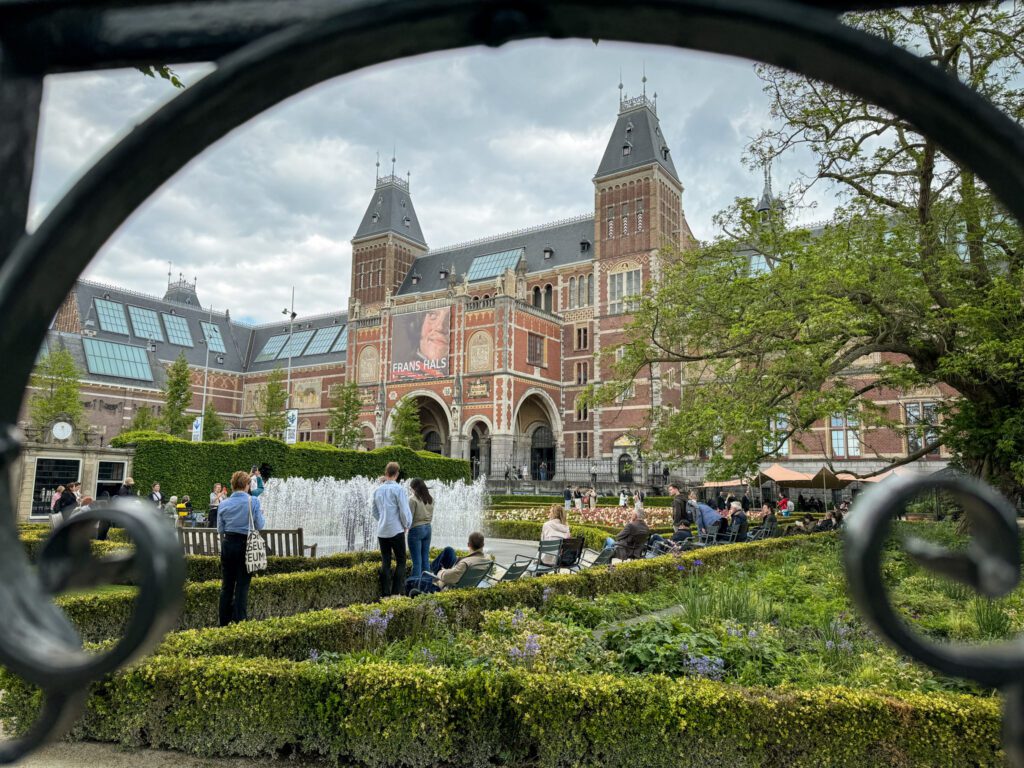
The Rijksmuseum is pretty clearly my personal favorite of the museums in Amsterdam, and it’s a great way to learn about two things.
One, the Dutch masters – namely Rembrandt and Vermeer, though there are others – and their influence on later artists (like the impressionists in France).
Two, the proliferation of art and wealth during the Dutch Golden Age.
It’s a vast collection spanning paintings, ship models, fashion, and even doll houses, and tells an interesting story about Dutch history.
I never really thought about it before my latest trip, but the Dutch Golden Age in Amsterdam is similar to the Renaissance in Florence in the sense that the immense wealth in the two cities led to the ability to hire the best artists in the region (and in some cases, the world).
The Dutch government administers the museum today, and has amassed a huge collection of art and artifacts that are on display in the photogenic brick building, which was built specifically to be an art gallery.
For me, the highlights are the Dutch masters, the doll houses, the tilework, and the ship models.
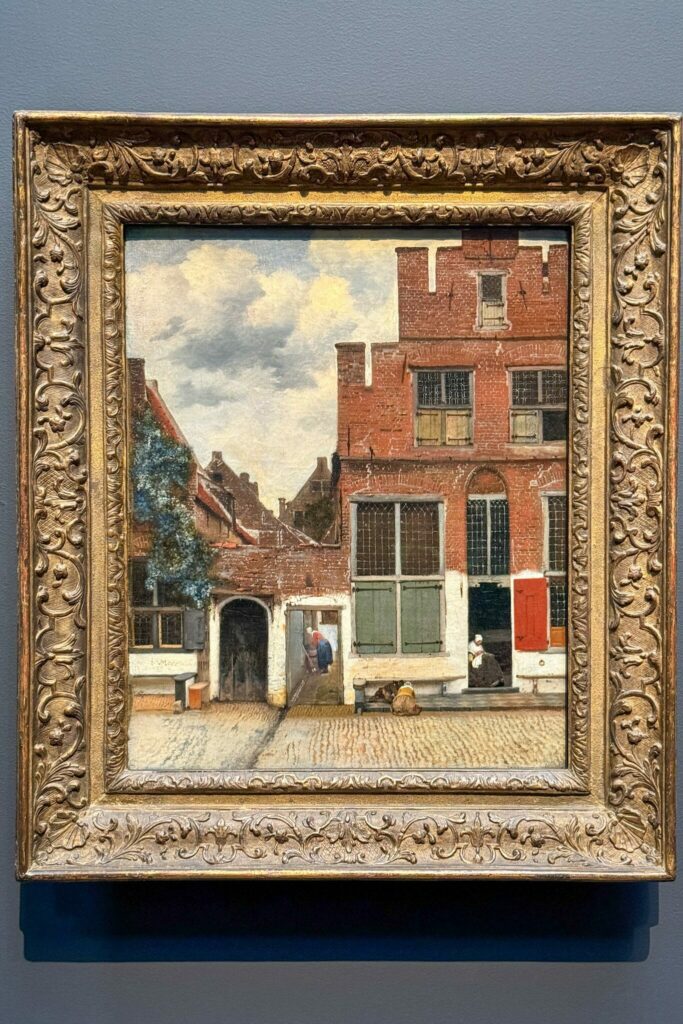
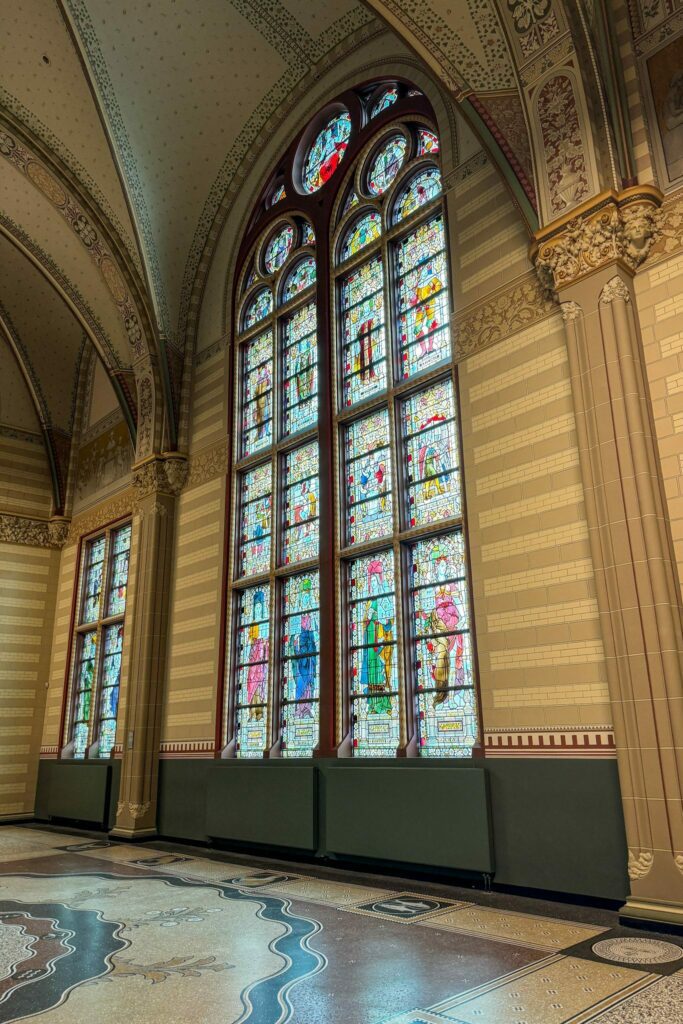
Because of the importance of context and history here, I’d do a guided tour if you can swing it, because it will lead to a much richer experience (and if you’re doing a guided tour of only one of the museums, this is the one I’d choose).
I did this guided tour with Context Travel, which is a great tour company that focuses on small group tours (this tour has a maximum of six people, which is ideal!) on history and hires expert guides (usually with some sort of higher education in the subject).
For my small group tour, I had Anna, who taught us A LOT about Dutch history through the art in the Rijksmuseum.
The biggest challenge with Context’s tours is their small groups tours are a little hit-or-miss in terms of availability (they usually have a few per month, more in high season).
They also do private tours, which might work out for bigger groups traveling together.
Getting Tickets for the Rijksmuseum
In terms of getting tickets independently, you have two options: buy them online in advance, or show up and wait anywhere from five to 90 minutes in the ticket office line.
It might already be obvious to you, but we highly recommend buying your tickets in advance. They do sell out – particularly during high season and on weekends – so as soon as you have an idea of your schedule, we’d go ahead and buy your tickets and work the rest of your itinerary around them.
You do have to choose a timeslot (and show up at that time), so you’ll be sacrificing a bit of flexibility by purchasing online in advance, but we think the tradeoff is worth it if you have limited time in Amsterdam.
To book your tickets, you’ll want to head over to the official website and click on the “Rijksmuseum Tickets” button (it’s in the top right corner on desktop).
You have a few options, including special exhibitions and a guided tour option, but if you just want the ticket, you want “museum entrance.” At the time of writing, it’ll cost you €22.50 per adult (kids under 18 are free!).
The Van Gogh Museum: A Deep Dive into the Life of Vincent Van Gogh
The Van Gogh Museum is also good, and it’s very different from the Rijksmuseum because, rather than being a vast collection of art amassed by the state over centuries, this is a limited collection telling the story of one man’s life.
The Van Gogh Museum was created in 1973 by the family of Van Gogh (notably, after the Rijksmuseum passed on buying his collection), and the architecture of the museum itself is VERY 1970’s.
Van Gogh is one of those artists who was never famous during his lifetime, and only became a household name after years of his family working to distribute his art around the world, eventually culminating in enough fame to open an entire museum in Amsterdam dedicated to his work.
The Van Gogh family is still involved in the museum and its administration to this day.
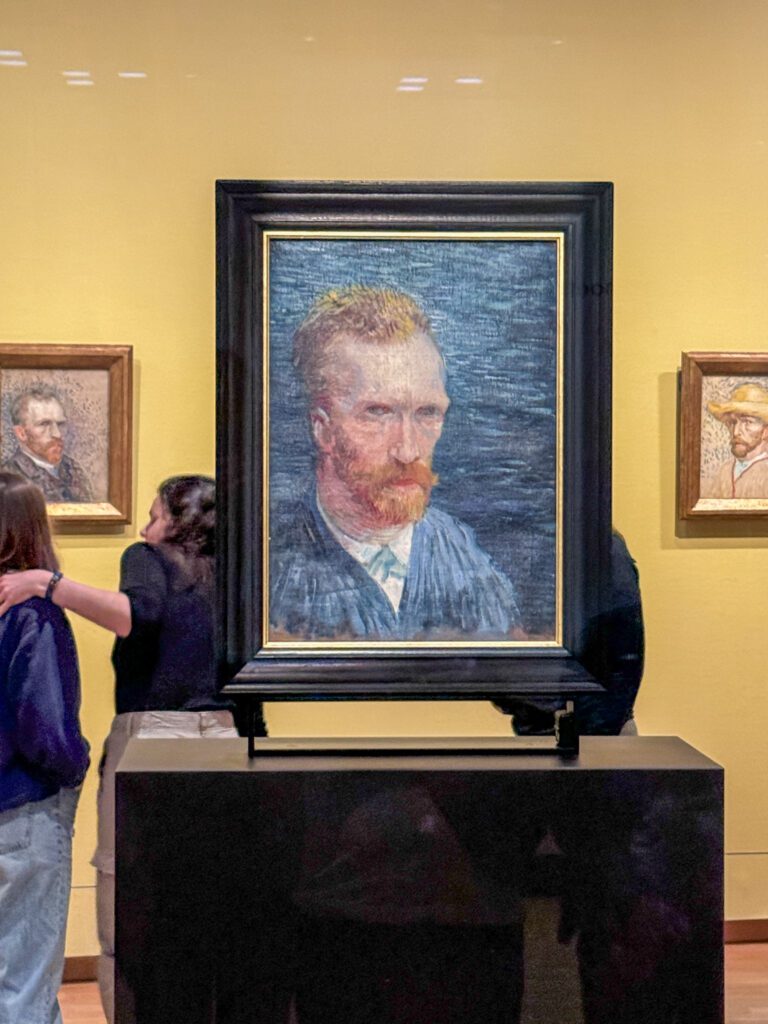
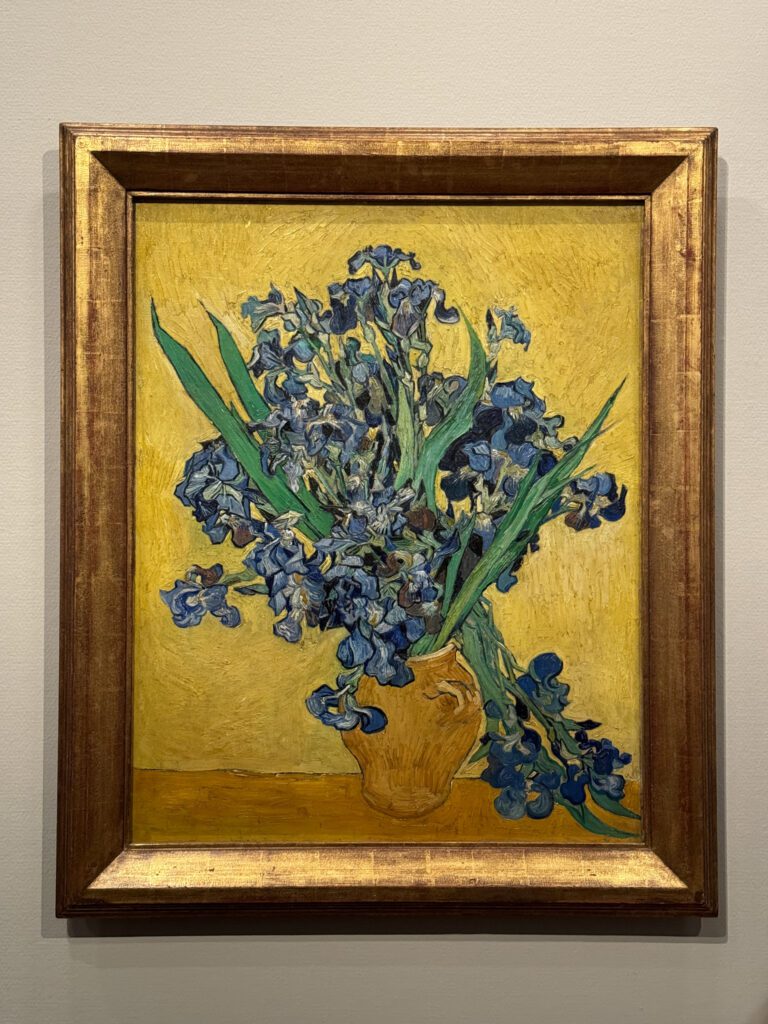
The thing that I like about Van Gogh’s work is his exploration of color. In a corner of the museum, there’s a small box of yarn that Van Gogh would use to visualize how different colors worked together – something he learned by living in a town of weavers early on in his career.
For example, in many of his self portraits, there are hints of blues in his skin tone, which is partially because the red/orange paint has degraded over time, and partially because he realized the two colors worked well together.
Blue is emphatically not a color I’d expect to see in the skin of a painted figure (unless they are dead or dying I suppose), but it works for Van Gogh.
Definitely spend some time getting close to his paintings to see the different brushstrokes and colors he’s using to create the bigger picture – it’s genuinely fascinating.
I did this guided tour of the Van Gogh Museum with Walks, one of my favorite tour companies in Europe (I’ve done 7-8 tours with them over the years).
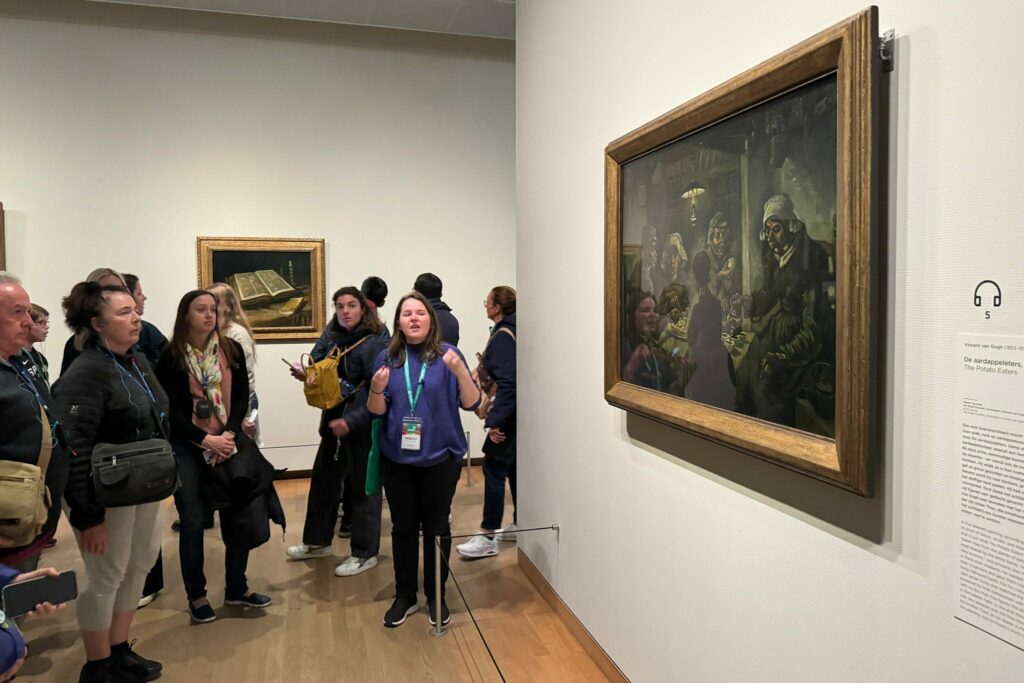
It enters the museum in the later afternoon, when the museum is a bit quieter (though it’s worth noting that it’s never TRULY quiet because it’s one of the most popular tourist attractions in Amsterdam), and your guide will spend two hours or so walking you through Van Gogh’s life and work, and what makes him special.
I’d recommend it, though if you’re doing one museum tour in Amsterdam, I do think it should be a tour of the Rijksmuseum where the historical and cultural context is a little less clear, and a guide will help bring the works to life.
Getting Tickets for the Van Gogh Museum
Similar to the Rijksmuseum, the best way to book tickets independently is going to be through the official Van Gogh Museum website.
It’s worth noting that you MUST book tickets (and a timeslot) in advance for this one, and they limit the capacity more strictly so it is more likely to sell out completely, especially on weekends during the summer.
At the time of writing, it’ll cost you €22 per adult (kids under 18 are free!).
If you’re not doing the guided tour that I did, I’d recommend grabbing the audioguide, which will cost you an extra €3.75 per person and give you a richer understanding of what you’re seeing in the museum. You can add it to your order when you’re booking your tickets.
It’s also worth noting that they do not have storage facilities for bags bigger than 45×25×25 cm, which means bigger backpacks and handbags aren’t allowed in the museum (and they will deny you entrance).
Backpacks, umbrellas, and coats can (and in some cases must) be checked at the self-service lockers, which are safe and secure.
Exploring the Grachtengordel and 9 Straatjes
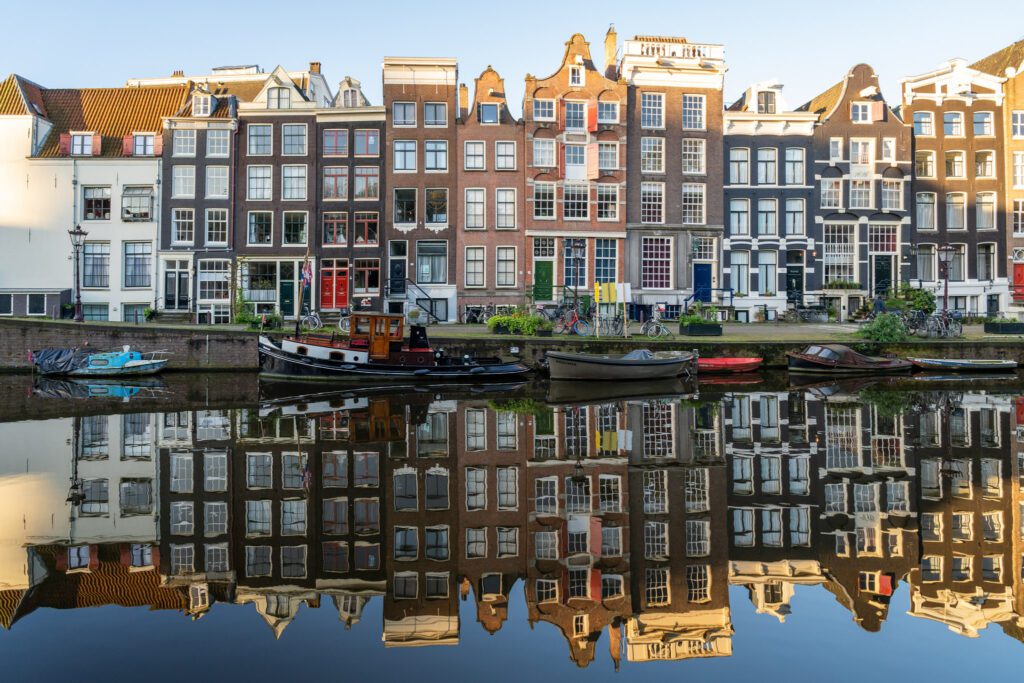
When you think of Amsterdam, the first thing you probably think of is the beauty of the canal belt, which is known as the “Grachtengordel.”
This is absolutely our favorite part of Amsterdam, and we should probably take a second to talk about the geography and difference between the two neighborhoods we’ve smooshed into one category here.
At a high level, Grachtengordel is the ring of canals that forms the half onion in central Amsterdam, and De 9 Straatjes (“Nine Streets”) is a very small piece of that broader neighborhood that refers to a block of three by three streets in the center of the Canal Belt (gotta love the Dutch direct naming conventions!).
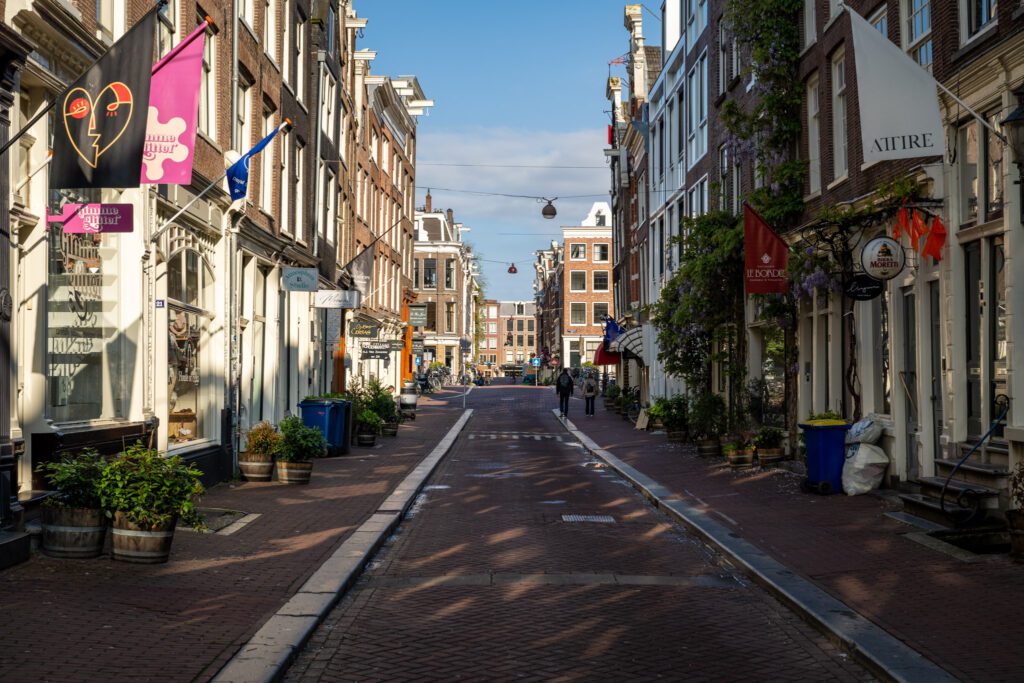
The broader neighborhood refers to the canals that were built in the 17th Century as an expansion to the old town (which is basically the area near the Red Light District and Dam Square today).
Specifically, Grachtengordel refers to those four canals that run from the River IJ on the north side of the city center (the river behind Centraal Station) in a counter-clockwise ring around the city to meet the Amstel River.
Broadly speaking, the most romantic and charming piece of the neighborhood is the area on the northwest side of the city center, closest to Centraal Station and the Jordaan.
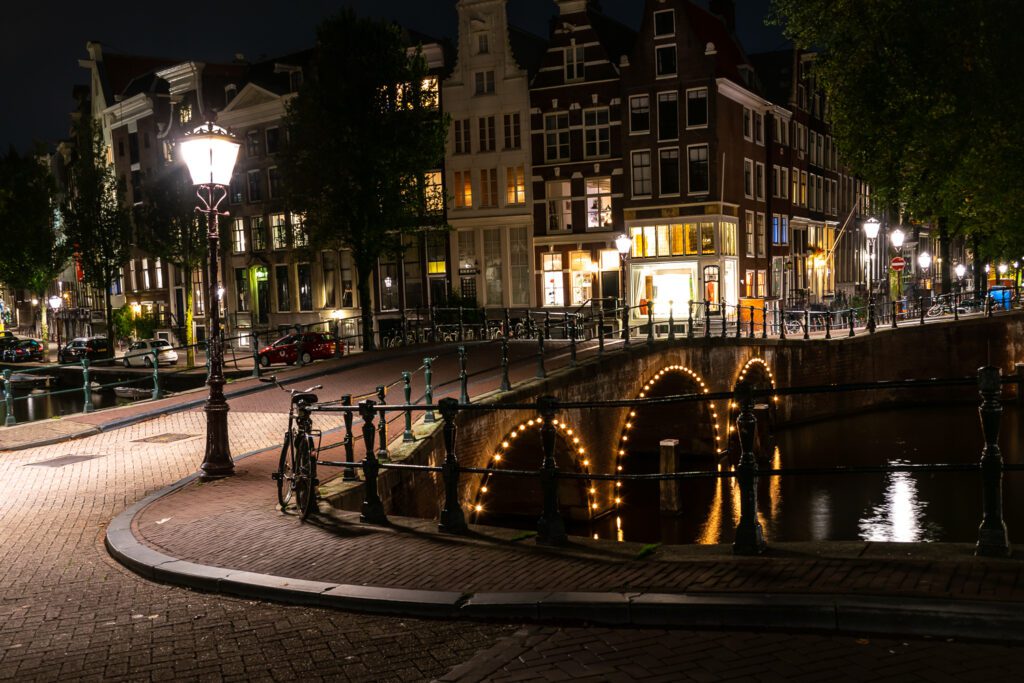
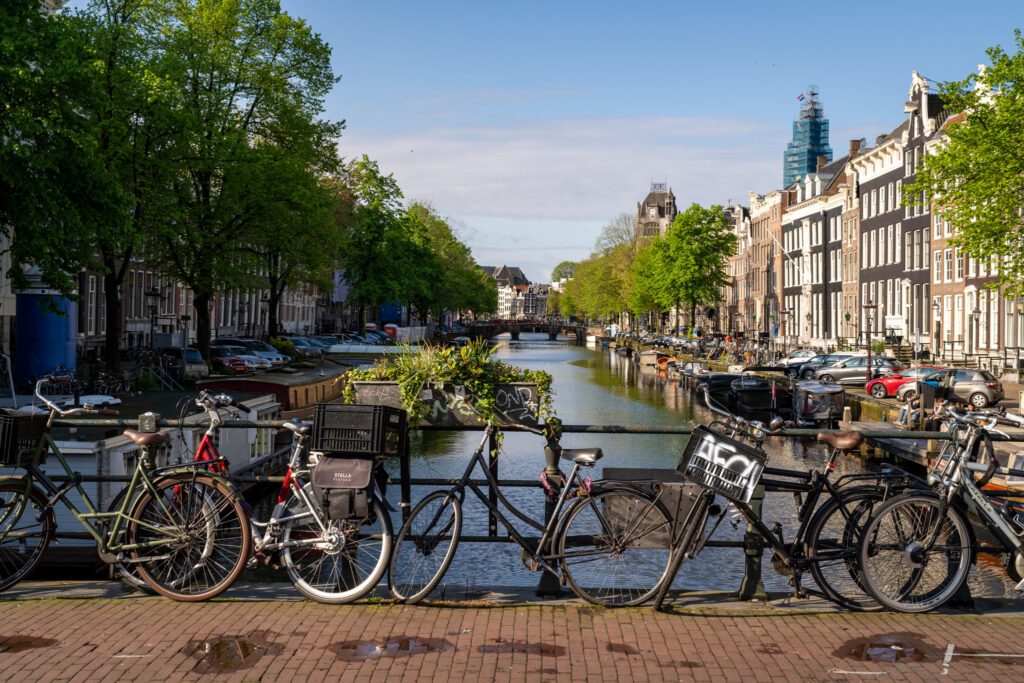
As you move south and east, this neighborhood gets a little less charming.
It was declared a UNESCO World Heritage site in 2010, so it’s very difficult to make updates and expansions of the historic buildings here, which is why many of them look like they were built hundreds of years ago (and many of them were – some have the year they were built up on the top of the building).
There are two times we like to be in this part of the city; in the early morning and the late evening, when the canals are remarkably quiet and peaceful. Particularly early on a Sunday, when Dutch people stay in bed until 10am (ish).
For a drink in this part of the city, go to either Tales and Spirits (my favorite cocktail bar in Amsterdam) or Proeflokaal Arendsnest (a historic beer bar on the canals with cozy wood paneling and TONS of beers on tap – both local and imported).
Dinner at an Indonesian Restaurant
One of the things I heard time and time again from locals in Amsterdam (I think it was literally mentioned on every tour) is the fact that, to this day, there is an expression in Dutch – peperduur – that roughly translates to “as pricey as pepper” because black pepper was brought over from Asia in relatively small quantities and, thus, was extremely expensive.
Anyway, the point is that the result of that (checkered) colonial past – especially combined with the fact that Amsterdam has been known as a bastion of tolerance for centuries – is that there are some cuisines represented in Amsterdam that I have truly never seen anywhere else in the world (or at least I haven’t noticed them anywhere else in the world).
One of those cuisines is Indonesian food, which was recommended to me by multiple people in Amsterdam (though I had already experienced it on previous trips at a place that offered gluten free options that has sadly closed).
So, on your first night, I think it makes sense to go ahead and dive into a new food experience (travel is all about stepping outside your comfort zone and learning, right?) and go ahead and try some Indonesian food.
Now, I have Celiac Disease, which means I have to eat strictly gluten free (hence the name of this website), and Indonesian food is not particularly Celiac-friendly.
However, I did the legwork of asking every local I encountered where I should go for Indonesian food (which you should also do if you do any tours).
Generally speaking, the further out from the center you get, the better it will be, so don’t be afraid to get on a tram and go on an adventure!
Here are a couple of places that were recommended (and that also look good to me)
- Sampurna: This was recommended by our Humans of Amsterdam guide Sinead, and someone from our group actually messaged the group to say they went and loved it.
- Kartika: Well reviewed (and recommended) Indonesian spot a few blocks north of Museumplein and Vondelpark.
- Paon Bali: The most authentic Balinese restaurant in Amsterdam, it’s a bit of a detour to the east of Amsterdam Centraal, but they have a rotating menu of the week that’s worth traveling for.
Day 2: The Jordaan, Anne Frank House, and De Pijp
On your second day in Amsterdam, start with a morning exploration of Jordaan, one of the most trendy neighborhoods in Amsterdam (though it has working class roots) and then move on to the Anne Frank House to learn about Amsterdam’s rich (and sad) Jewish history.
Then, snack break! Take some time to try a few Dutch delicacies before ending your day in De Pijp, our personal favorite neighborhood in Amsterdam.
Coffee and Pastries in the Jordaan
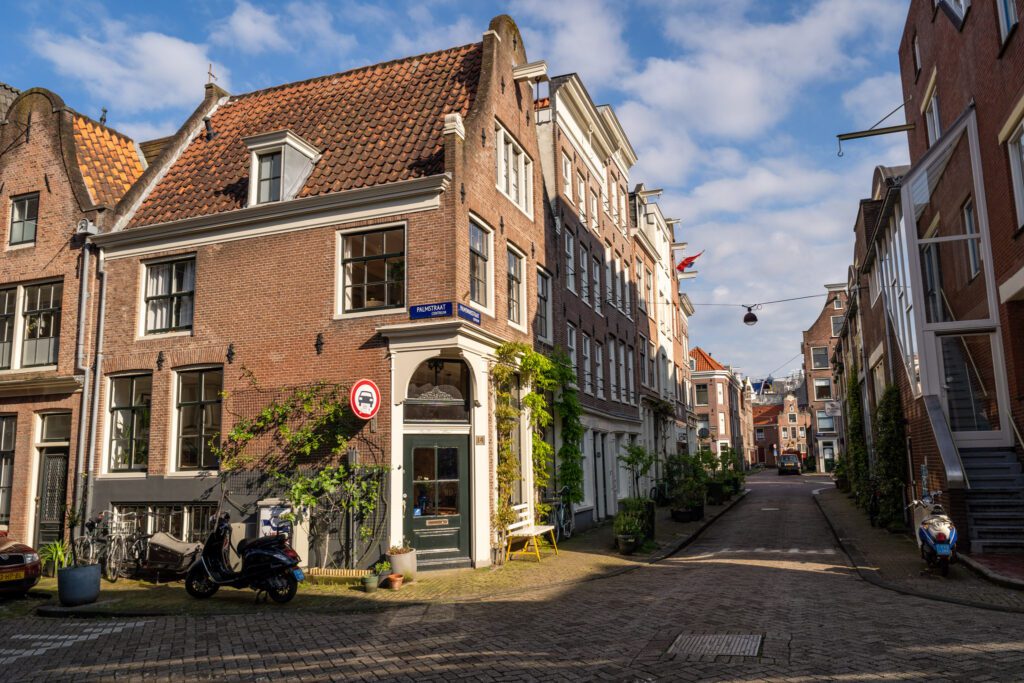
Start your second morning in Amsterdam off with a walk through the Jordaan, which is a neighborhood with an interesting story that you’ve almost certainly heard before.
While the Canal Belt is where the rich people settled in Amsterdam as it was becoming a hub for global commerce in the 16th and 17th Centuries, they quickly came to the realization that they were going to need a place for all the workers to live, who they needed to maintain their easy lives.
Enter Jordaan. It’s close to the rich people’s houses, but it was very much a working class neighborhood until very recently.
It’s on the outside of the belt of three canals that were added to the city during the Golden Age, and it’s more dense and the houses are far (FAR) less ornate than the houses on the prized property along those three main canals.
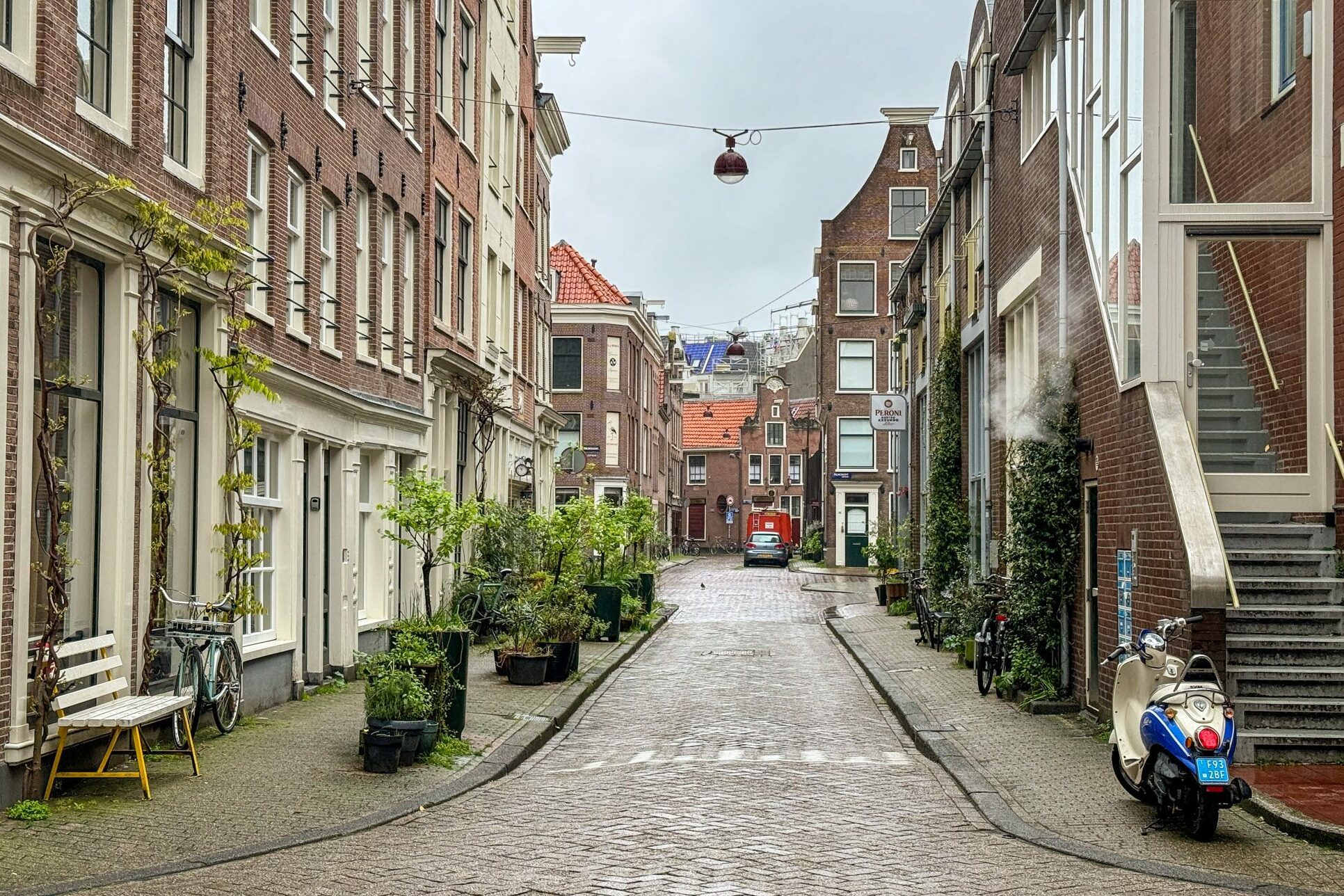
As you’re walking along the narrow streets in the Jordaan, it’s easy to imagine the tough living conditions before this area was developed and fixed up.
During the mid 20th Century, this area was one of the poorest neighborhoods in the city, and conditions here were dire in terms of sanitation and cleanliness. Which is hard to believe walking through the area now.
However, like many former working class neighborhoods around the world, a funny thing happened with the Jordaan over the past 20 years or so.
First came the artists and students, who moved there for the cheap housing.
Then came the businesses catering to (or opened by) the artists and students.
Then came the hipsters, looking for the next cool thing.
And, finally, the yuppies arrived. And now it’s one of the most expensive and desirable neighborhoods in the city.
It’s an interesting blend of businesses that have been there for decades and newer offerings, and it’s sometimes easy to tell the difference.
Spend your morning walking through the Jordaan before stopping somewhere for coffee and pastries to fuel you up for your next stop.
Our top recommendation here, both for coffee and pastries, is Saint-Jean, a famous bakery and specialty coffee shop that is entirely vegan (they don’t even offer dairy milk in their coffee drinks).
However, that doesn’t stop them from making some of the best pastries in the city.
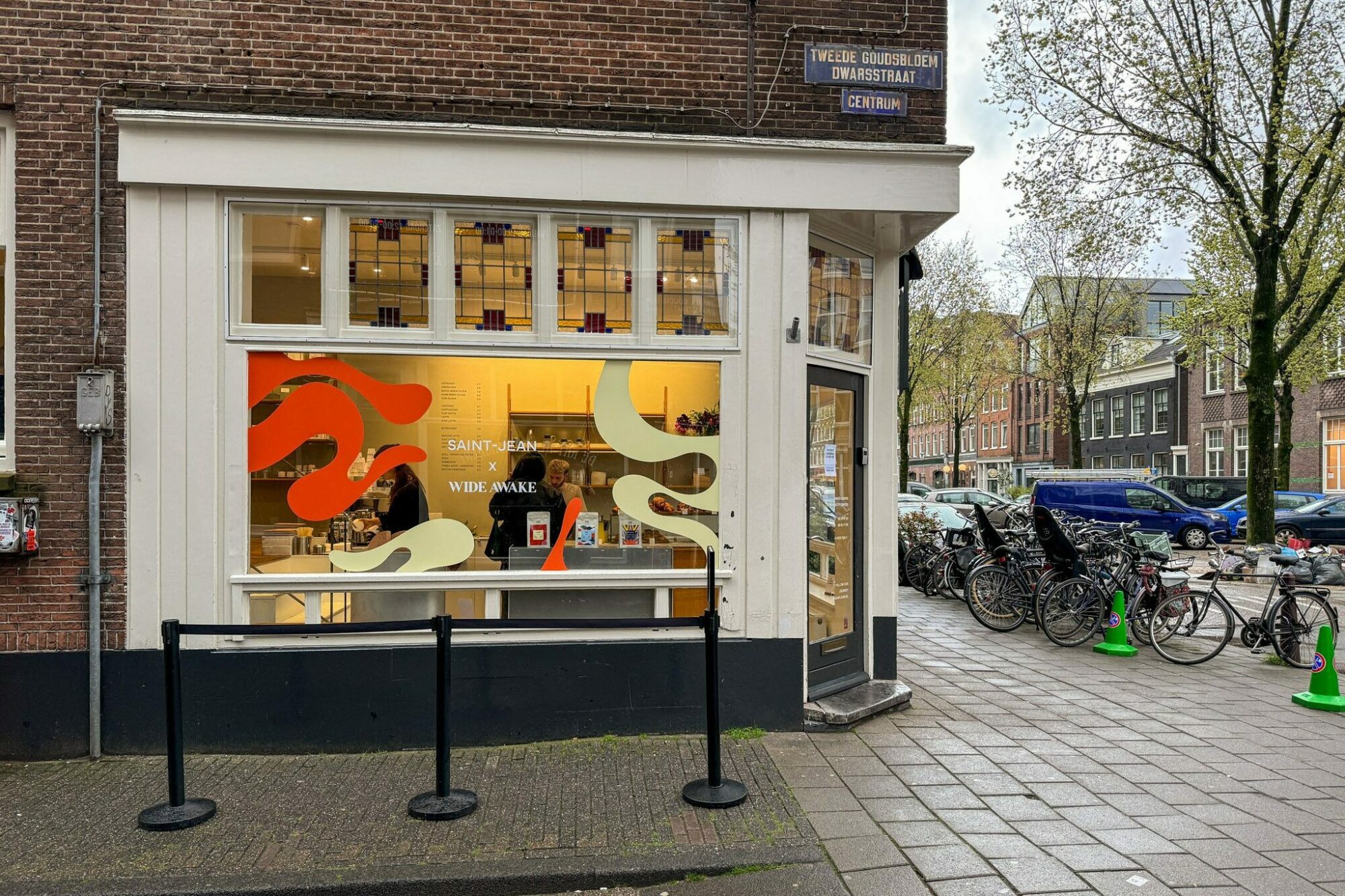
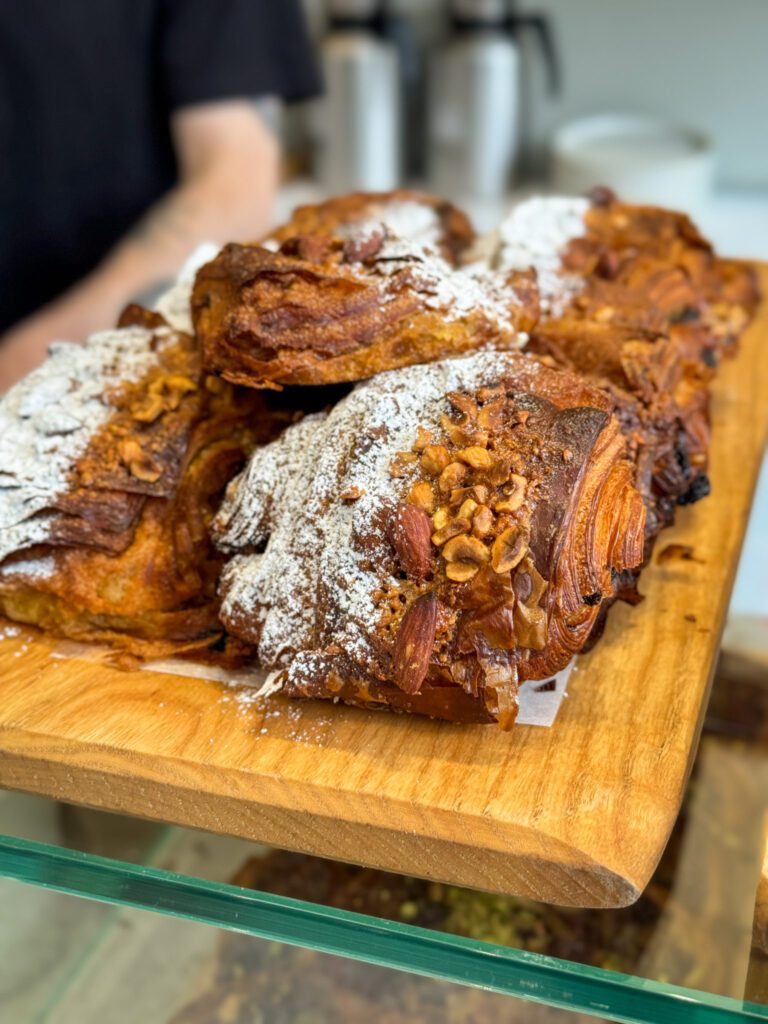
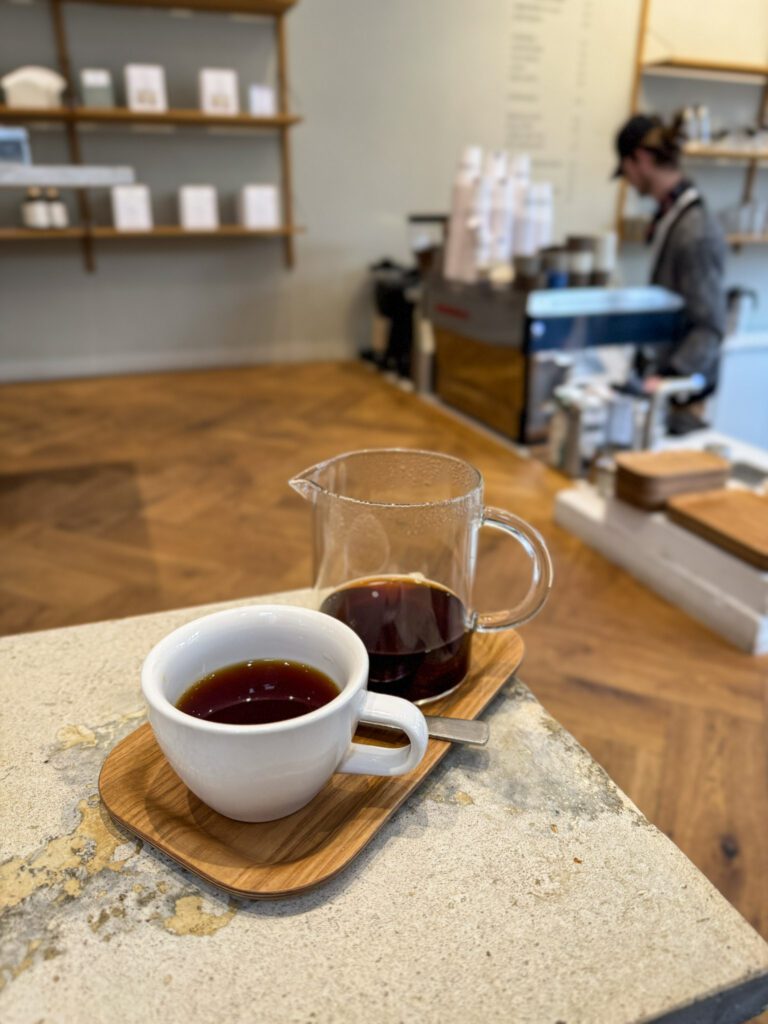
It’s a very busy spot, especially around mid-morning, and there are legitimately only 6-8 seats inside.
I asked what the best time to come would be on one of my multiple trips here (I was here for the coffee – it was my favorite coffee shop in Amsterdam!) and the baristas said around opening, before the Dutch people are awake.
If there is a line and you don’t feel like waiting, you can head across the street to their deli, which has a more limited selection of both coffee and pastries, but also usually has no line.
Otherwise, there are a couple of other good options in the neighborhood that I enjoyed.
Toki is a cool spot in the Jordaan on a corner, and they serve coffee from a variety of European roasters (including Bonanza of Berlin) in a welcoming space with some good seating options.
Good Beans is a literal hole in the wall around the corner from Toki that also serves great coffee, and they also have a small selection of pastries.
Dive into Amsterdam’s Jewish History at the Anne Frank House (or a Jewish Walking Tour)
This is where we’re going to get to what is probably our hottest Amsterdam take; the Anne Frank House is overrated.
Yes, it brings the tragic story of Anne Frank to life if you’ve read her diary (it was required reading in high school for us). Stepping inside the secret annex is quite the experience.
The reason we’d say that it’s overrated is twofold.
First, it is a hassle to secure tickets, which needs to be done six weeks in advance nearly to the minute (at least during peak season).
Second, for obvious reasons, it’s laser-focused on Anne Frank and her experience at the expense of the broader history and context around the Jewish community in Amsterdam, which is a fascinating story that is intertwined with the history of Amsterdam itself, and we think that learning about that history outside of the 1940’s is worth your time.
And, again for obvious reasons, that story is largely a sad one. And we think that a more holistic picture of the Jewish community’s history in Amsterdam actually has some high points and things worth celebrating alongside that sadness.
At a high level, Amsterdam’s role as a bastion of tolerance – which persists through the present day – has existed basically since the city was placed on a map many centuries ago.
Amsterdam was one of few places in Europe that was outside the purview of both the church and nobility, which means it could largely march to its own drum.
You might be wondering what exactly this has to do with the Jewish community.
That tolerance extended to religious freedom, and while Amsterdam was majority Christian, it did not have the same level of anti-Semitism that existed in places like Spain, Portugal, and eastern Europe.
At various points in history, Jews were expelled from basically every other country in Europe, and many of them found their way to Amsterdam, where they faced far less persecution than their home countries (where they were blamed for basically everything bad that has ever happened).
That’s the executive summary of about 1,000 years of history, and it’s worth diving deeper into that history because we think it tells you something unique about Amsterdam.
So in this section we’re going to give you two options; the Anne Frank House, and a walking tour through the Jewish Quarter – which is NOT where the Anne Frank House is located – that Matt did on his latest trip to Amsterdam and LOVED.
The Anne Frank House
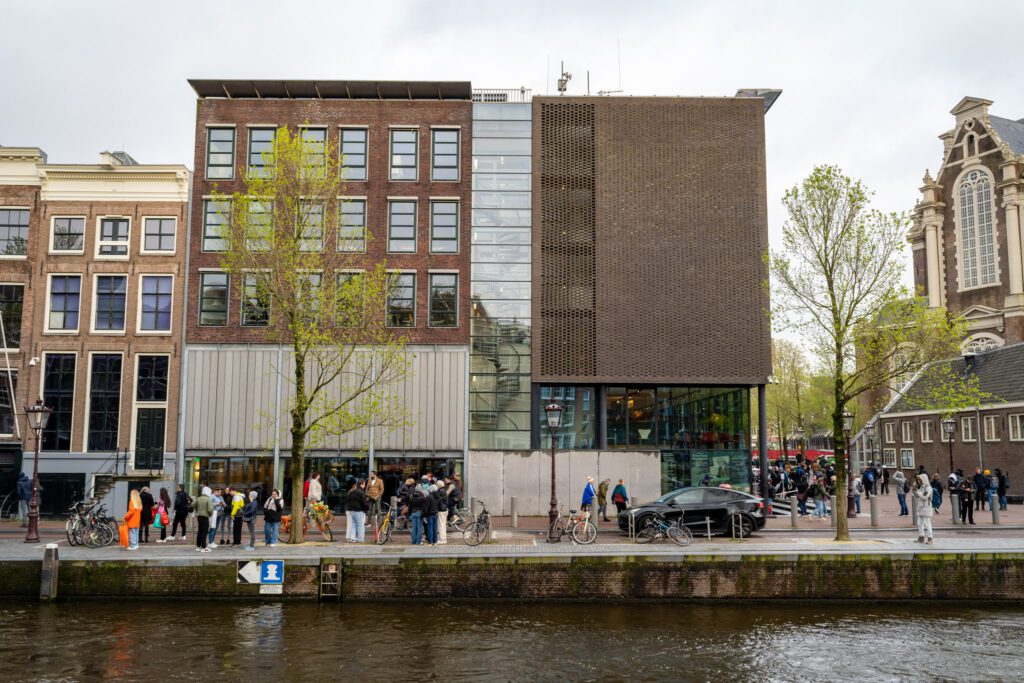
I have somewhat mixed feelings on the Anne Frank House, which I visited on my first trip to Amsterdam.
On the one hand, as someone who read Anne Frank’s Diary in school growing up, it’s cool to visualize the place that I read about and see the bookcase and annex where the story takes place.
On the other hand, as an older adult, I vividly remember walking out of it and thinking “that’s it?”
The problem with the Anne Frank House, at least for me, is that it’s laser-focused on one family’s experience, which totally makes sense! However, it leaves out some of the context around Amsterdam’s Jewish community as a whole, and what life was like in Amsterdam during that dark period.
The other problem is that it is just ridiculously busy, and you essentially have to book your tickets right when they go on sale (more on this in a second, don’t worry) if you’re traveling in the high season.
If you want that extra context (or you missed the deadline to get tickets), I have an alternative experience just below that you might enjoy.
Otherwise, let’s talk about the Anne Frank House. This is the actual house (or, more accurately, part of this complex is the house) where the story took place, and it has largely been preserved and recreated to be more or less what it was like when Anne Frank was writing in her diary.
Getting Tickets for the Anne Frank House
There is only one place to get tickets for the Anne Frank House, and that’s the official website.
You MUST book a timed entry slot and ticket online in advance of your trip.
There are no guided tours that you can book through other platforms and there are no onsite ticket sales, so if you don’t get a ticket when they go on sale and they end up sold out for your dates (which definitely happens in the summer), you’re out of luck.
Tickets go on sale six weeks in advance at 10am CET on Tuesdays (1am PST, 4am EST), which isn’t particularly convenient for Americans. You don’t need to necessarily get online RIGHT when they go on sale, but it’s probably a good idea to check in on tickets that morning if you can swing it.
At the time of writing, tickets for the Anne Frank House will cost you €16 for adults and €7 for children between 10-17 (only a single Euro for kids under 10).
The main decision point, aside from time and date, is whether or not to pay extra for the 30 minute introductory program (in English) before the museum, where a museum educator will spend some time giving you some of the context I felt was lacking on my visit a few years ago.
It’s an extra €7, and for what it’s worth, my mom thought it was well worth it when she did the Anne Frank Museum for the first time in May 2024.
A Jewish History Walking Tour
On my latest trip to Amsterdam, I decided that I didn’t really need to do the Anne Frank House again.
However, after learning about the broader history of Amsterdam on my walking tour with Anna, the idea of Amsterdam’s famous tolerance for a wide variety of peoples and ideas piqued my interest.
Based on what I had learned to that point, the Jewish community in Amsterdam was a good place to learn about that idea.
I chose this walking tour which dives into the history of the Jewish community in Amsterdam on a walk through Amsterdam’s Jewish Quarter (which, again, is NOT where the Anne Frank House is located).
If you want to go beyond the famous diary and get a more holistic picture full of history and cultural context, I cannot recommend this tour highly enough.
HOWEVER, it is VERY IMPORTANT to know that this tour DOES NOT include a visit to the Anne Frank House (it’s on the other side of the city), so this isn’t a good option if you really want to visit the Anne Frank House and think this tour is a way to get a guided tour (or a last minute ticket).
Snack Break! Apple Pie, Fries, and… Pickled Herring?
After a morning of learning, it’s snack time (just like kindergarten!).
There are three things in the vicinity of the Anne Frank House and Jordaan that we think you should try, and you can choose one, two, or all three of them depending on how hungry you are and what you’re looking for.
Dutch Apple Pie
The first is apple pie, which is a Dutch classic. However, as I learned over the course of my latest trip, there are different interpretations of apple pie. Some lean more sweet (this is the more modern take), some lean less sweet and more apple-y (this is the traditional way).
Lucky for you, two of the best places for apple pie in Amsterdam are within a few blocks of each other in the Jordaan, and they offer an opportunity to try apple pie on both ends of the spectrum.
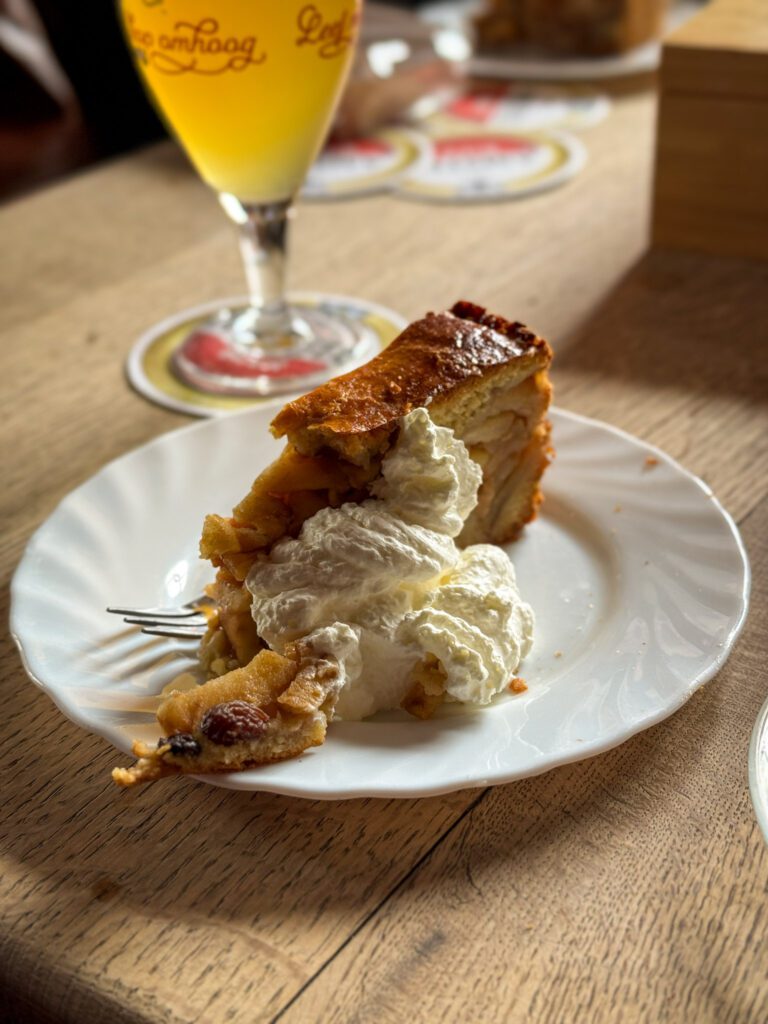
Winkel 43 is the more modern take on apple pie, and it’s a much more hip and streamlined operation on the interior.
Het Papeneiland is the more traditional option, and as soon as you step inside you’ll see what I mean. It’s a historic brown cafe, which basically just means an old bar (where the interior is largely brown, mostly because it’s made of wood).
Fries
The second snack to try here is fries, which is another classic Dutch snack. Usually, they’re served in a big cone, topped with mayo (though there are lots of other topping options), and come with a little serving stick that you can use to poke the fries without getting your hands too dirty.
We have two options for you here too.
The first is Fabel Friet, which is a tiny little storefront in the 9 Straatjes (here on Google Maps) slinging fries and croquettes.
Apparently they got famous on Tik Tok relatively recently (I wouldn’t know, when I try to download Tik Tok my phone sees the gray hair in my beard and goes NOPE), but I came here because it got good gluten free reviews.
This is a more modern take, and they break the mold by offering their fries topped with shaved cheese (parmesan or cheddar, and the answer is parmesan) and sauce (truffle mayo is the answer). It’s a popular spot, but it’s DELICIOUS.
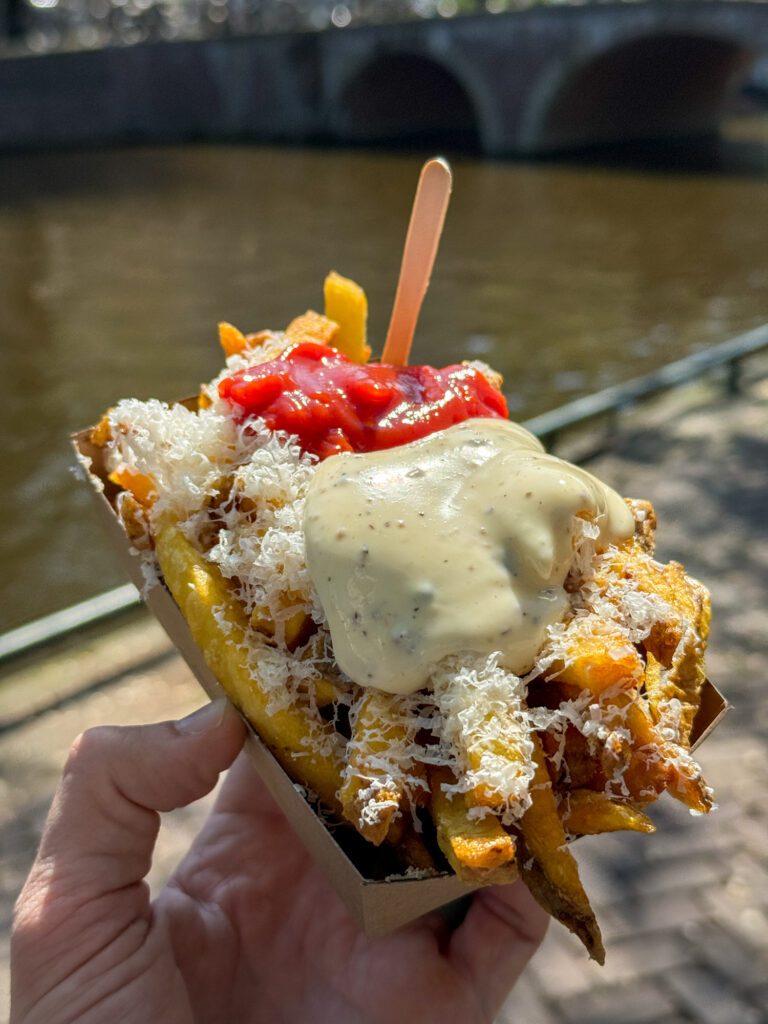
For a more traditional take, head over to Heertje Friet, which is two blocks away from the Anne Frank House (here on Google Maps). Their menu is more simple and straightforward, but no less delicious.
Pickled Herring
Now for the last recommendation, and this is easily going to be the most polarizing of the three for obvious reasons; pickled herring.
First of all, pickled herring is pickled, but it doesn’t really have that vinegary flavor that you’d expect from something pickled, and the texture of the fish is really nice – silky and smooth, kind of similar to sashimi.
The reason that pickled herring deserves a try is its pivotal role in the Dutch Golden Age. Similar to dried bacalao in Portugal, pickled herring keeps for a longgggg time, which is useful if you’re sailing halfway around the world to, say, southeast Asia.
Similar to windmills, which were used to cut wood (among many other uses!) that was floated up the river to build ships out of, pickled herring is one of the things that allowed for the rise of the Dutch empire and almost directly led to their golden age.
Today, pickled herring is served either plain with diced onions and pickles, or on a sandwich (basically the equivalent of a hoagie roll with the fish and accouterments inside).
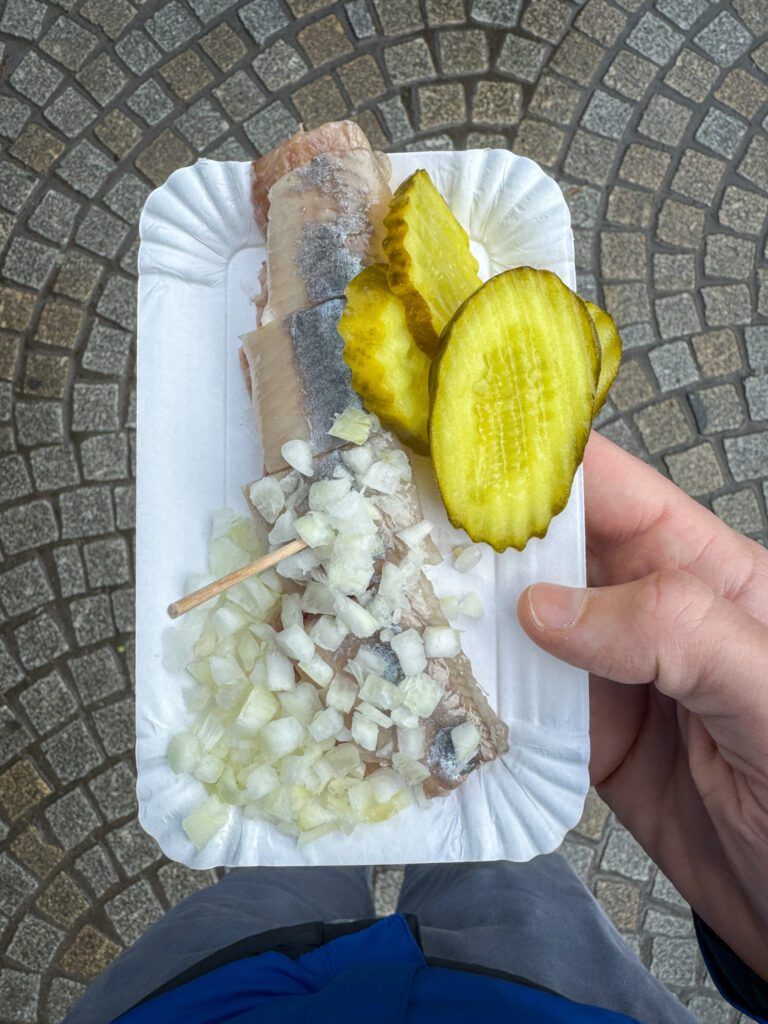
There are a few places to try it – usually at a little pop up stand – and I personally tried it at this stand right off of Dam Square on my private walking tour with Anna (through With Locals, one of my favorite tour companies in Europe).
The other recommendation I got from Sinead from my Humans of Amsterdam walking tour was Stubbe’s Haring (here on Google Maps), which is a few blocks from Amsterdam Centraal at the very northern end of the canal belt.
I know I know – it doesn’t sound great. But I got an order, promising that I would have at least one bite because I expected it to be extremely fishy (which I’m not into), and ended up eating the whole thing.
De Pijp and the Albert Cuyp Market
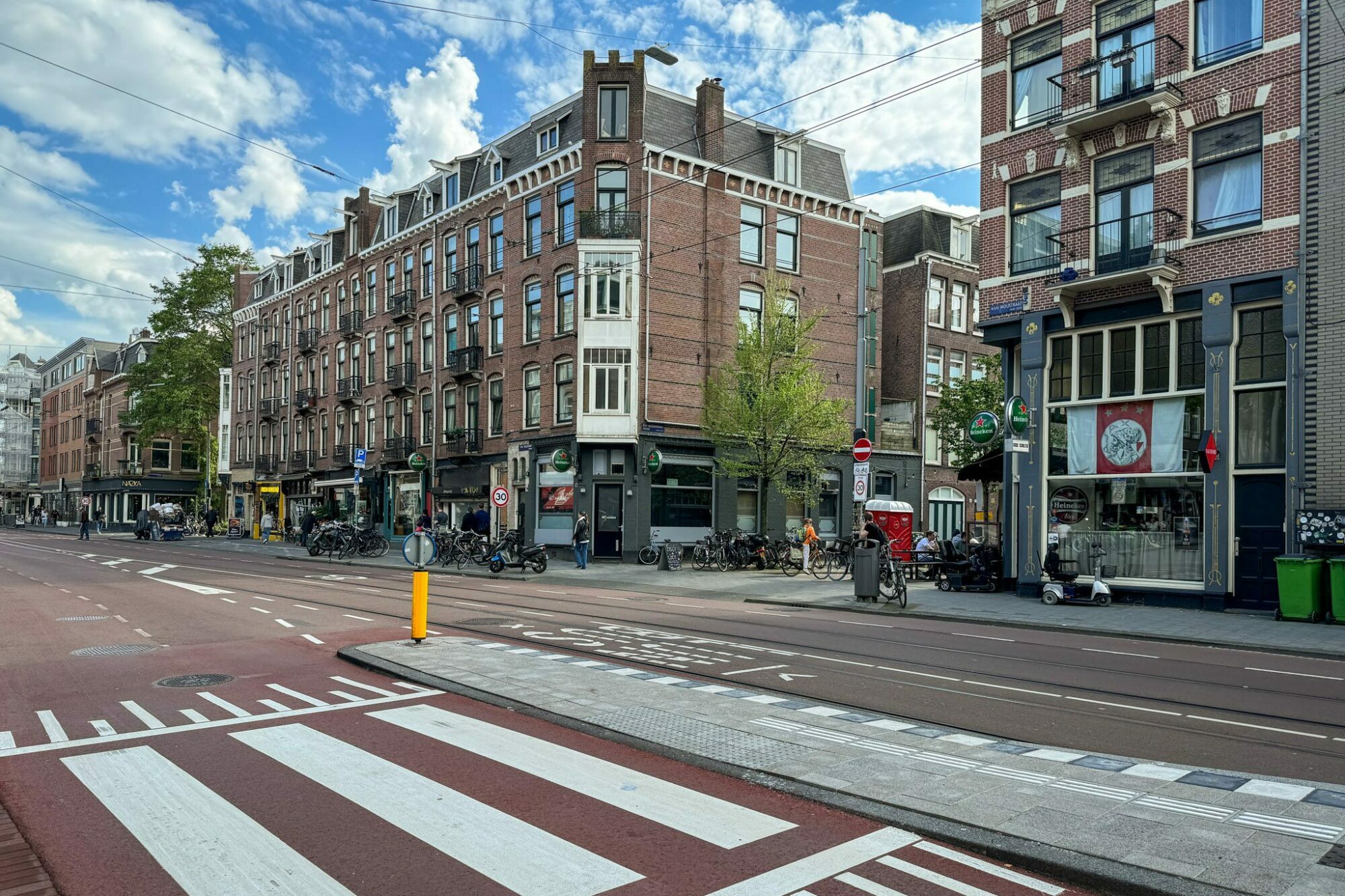
Overall, De Pijp is probably my favorite part of Amsterdam. If I was moving to Amsterdam, it would likely be the first place I’d look to live.
After my first trip to Amsterdam, I viewed De Pijp as the place where the Albert Cuyp Market is, and didn’t think much beyond that. Yes, the Albert Cuyp Market is great, and is well worth a visit. But there’s A LOT more to De Pijp than that one delicious street.
I happened to be staying a few blocks east of De Pijp for part of my trip, and ended up spending a good amount of time walking through the neighborhood over the course of a week of exploring Amsterdam.
Essentially, De Pijp is a little manmade island just outside of the Singelgracht (one of the canals that makes up the Grachtengordel) that is adjacent to Museumplein.
Within that island, you basically have everything you need in terms of living; great food and drinks (see “highlights” below for my favorites), multiple nice shopping stretches (I particularly enjoyed Ceintuurbaan and Van Woustraat), and an unexpected park in Sarphatipark.
However, as far as whether or not it makes sense to stay here as a tourist goes, it suffers from one major drawback; it’s very residential with very few places to stay (which is most of the reason why it feels like such a local vibe).
Here are a few places worth checking out in De Pijp (including the famous Albert Cuyp Market), though I bet you’ll discover one or two more as you’re exploring yourself.
The Albert Cuyp Market: The five block stretch of Albert Cuypstraat in the middle of De Pijp comes alive with the Albert Cuyp Market every day from 9:30am to 5:30pm except Sunday. It’s worth a browse, with a mixture of food vendors selling groceries (like cheese, meat, dairy, etc), food trucks selling ready-to-eat food, and flea market-esque vendors selling random knick-knacks. Don’t miss fresh-pressed stroopwafels from Rudi’s (find their food truck times and locations here).
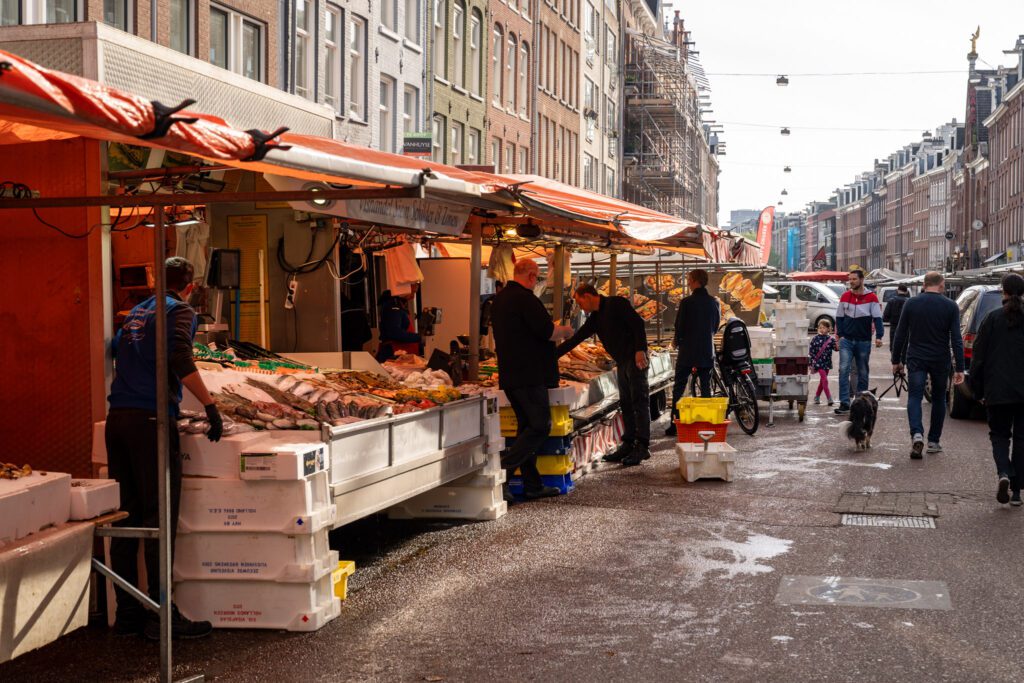
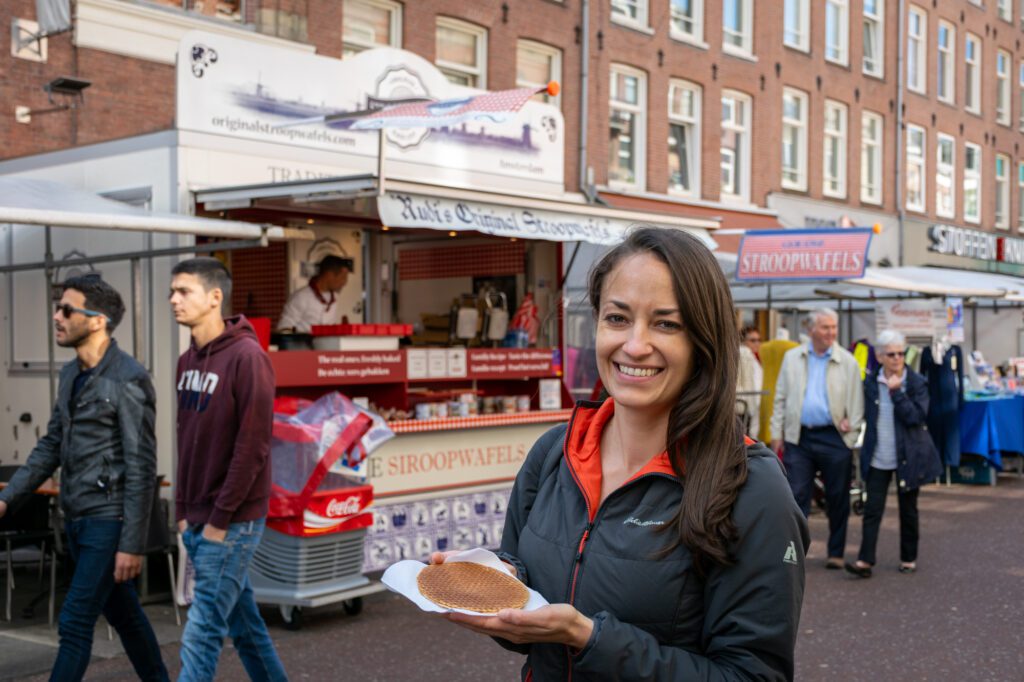
Glou Glou: A great natural wine bar on a busy corner in De Pijp. I’ve been here every single time I’ve been in Amsterdam, and it hasn’t disappointed yet. Get a table on the patio on a warm sunny day for maximum pleasure.
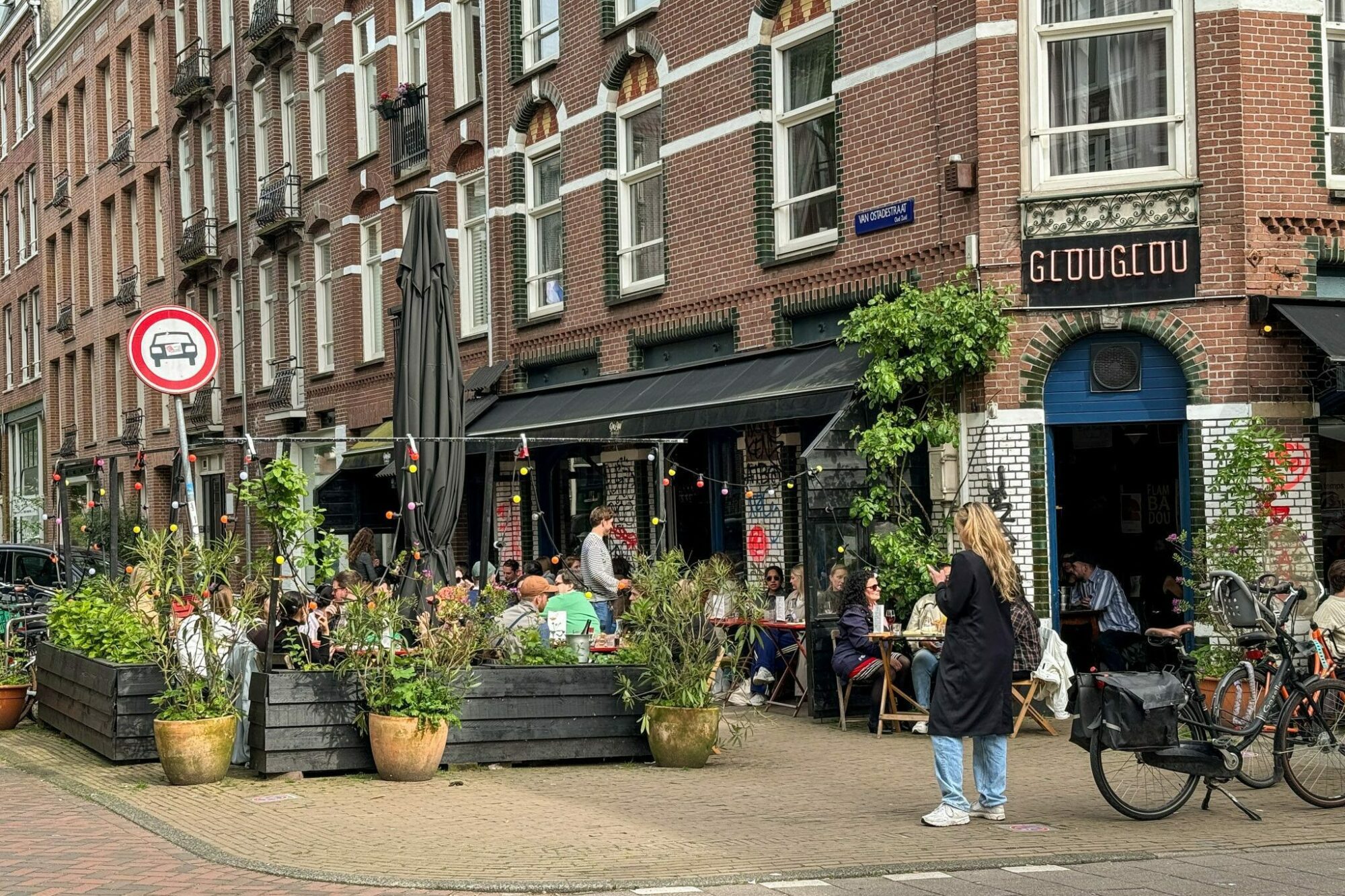
Bierbaum: A cool little craft beer shop that I stumbled upon on my explorations of De Pijp. They have a good selection of local and imported beer, along with some local craft ciders.
Craft Coffee & Pastry: If you or someone in your group are gluten free, run – don’t walk – straight to this gluten free bakery in De Pijp. It was even recommended to me at a bakery that was NOT gluten free (I was there for the coffee) as a must-visit place when I told them I have Celiac Disease. There will likely be a line, and the best selection is available at opening. Get there 15 minutes early to be one of the first in line!

Clay Coffee (and Pottery Studio): My favorite coffee shop in De Pijp, it’s just across the street from the eastern end of the market, and they have a couple of rotating roasters that they use (including Sey, my favorite roaster in the USA).
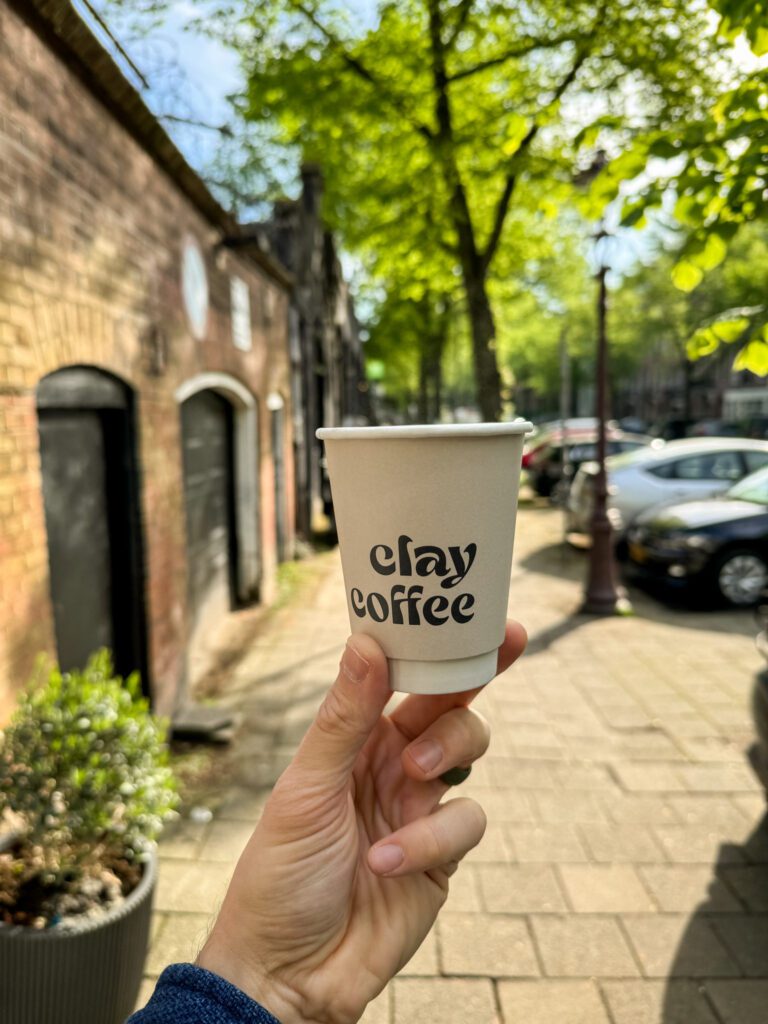
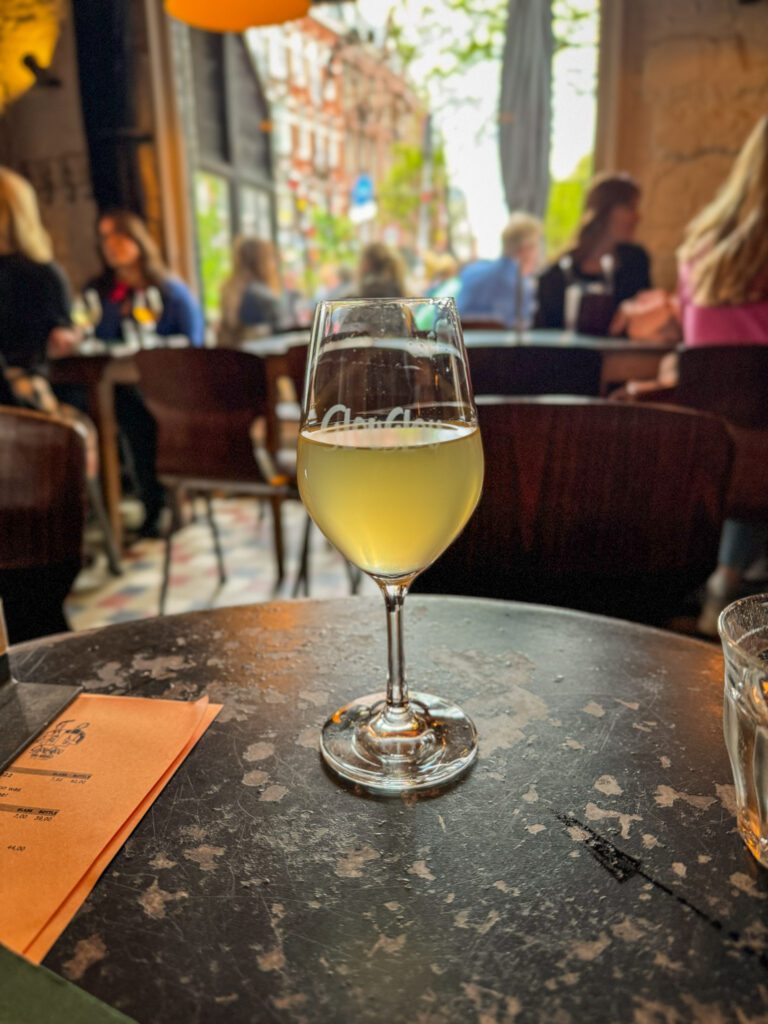
What to Add with More Time in Amsterdam
Here are a few things worth adding to your itinerary if you happen to find yourself with more time in Amsterdam.
The Tulips at Keukenhof (+1 Day)

One thing I learned on this latest trip – which was in the spring of 2024 – is that the most popular time to visit Amsterdam (especially for Europeans and Dutch tourists) is not actually the summer, but the month or so in the spring when the tulips are blooming.
Tulips, it turns out, are a HUGE thing in Amsterdam, though they aren’t actually Dutch (they were brought over from Turkey).


I happened to be visiting Amsterdam in mid-April, and it ended up being peak bloom for the tulips in Amsterdam, and I decided I had to go see them.
It’s only open from April to mid-May, and the peak bloom time is generally somewhere in the second or third week of April.
The most accessible place to see tulips is Keukenhof, but there are a few things you should know going in to avoid disappointment.
First, it is a giant tourist trap. It’s expensive. It’s crowded. And it’s 100% catering to tourists.
Second, it’s not particularly easy to get to from Amsterdam. You have to go out to the airport (or to RAI, a train station in southern Amsterdam) to catch a bus that will take you there.
Third, you should definitely pack a lunch because the food options are terrible (basically cafeteria food, but at fine dining prices).
The result is a potentially expensive and disappointing day out.
However, I think like many of the major tourist attractions around Europe, there is a way to do it to minimize some of the negatives.
First, you should go as early as humanly possible. The gardens open at 8am, and you should get on the earliest bus you can (TBD what this looks like – I can’t see the times now that it’s closed for the season).
Second, you should consider a tour. It’s a much more convenient way to do it to avoid the bus situation, and it’s also a way to get out there early.
I did this tour with Chris, which got us to the gardens right around opening before whisking us away to the windmills at Zaanse Schans for the afternoon.
Overall, I enjoyed Keukenhof, but I do think the early start was VERY important because we had the place to ourselves when we arrived, and by the time we left there were literally thousands of people walking around the entrance and I can see how that wouldn’t be particularly pleasant.
Add Another Museum (The Dutch Resistance Museum and the Amsterdam Museum)
One thing you could do with some extra time is to simply add the major museum that you didn’t do in the main itinerary (either the Rijksmuseum or the Van Gogh Museum).
Both are great for different reasons, and that’s probably the first thing we’d add to the itinerary above.
However, there are two other museums in Amsterdam that are also worth a mention.
The first is the Dutch Resistance Museum, which covers the dark period during World War 2 when the Netherlands was occupied by German forces.
This museum weaves a pretty compelling narrative around the Dutch resistance – the group who was doing their best to protect the Dutch people (particularly the Jewish community).
The thing I liked here was that they gave the bigger picture of what life was like in Amsterdam, but also covered the individual acts of heroism that don’t really show up in history books, but are the important pieces that ladder up to that bigger picture.
The second is the Amsterdam Museum, which is a good historical overview of the history of the city. .
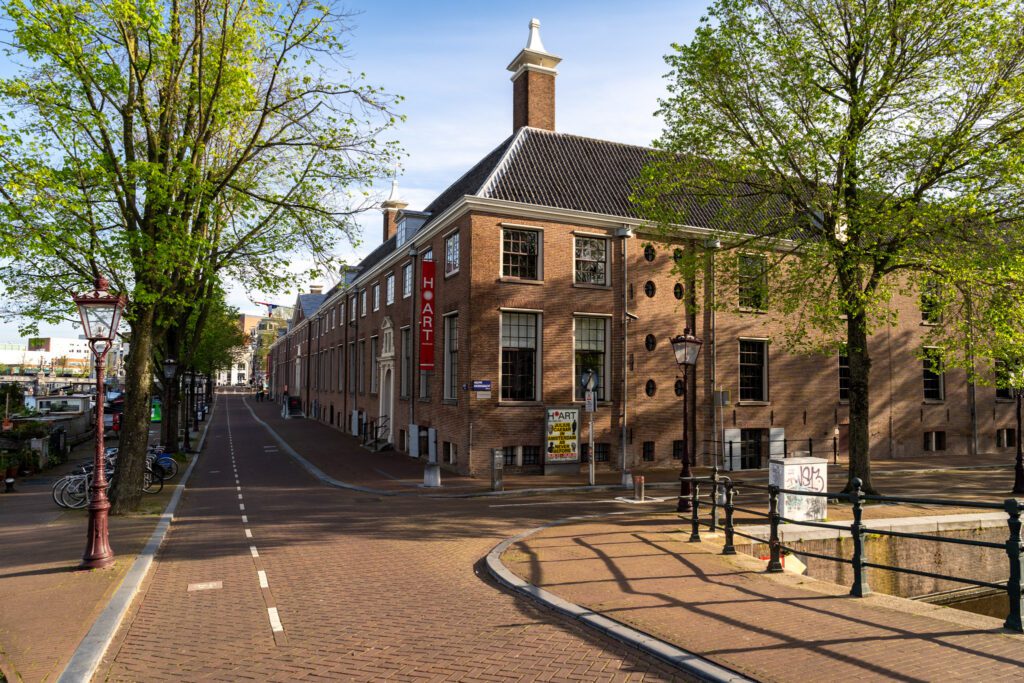
And it’s compact! You probably only need an hour or two to see it, and that’s if you take advantage of the free audio guide to get the narrated part of the story behind the artifacts they have on display (you should).
What to Do with One Day in Amsterdam
With one day in Amsterdam, we’d focus on three things: the canal cruise, one of the museums, and De Pijp, with some of the food items sprinkled in for good measure.
This does mean making some hard choices, notably between the museums (we probably wouldn’t try to do the Rijksmuseum AND the Anne Frank House, but you could probably make it work if you were desperate to do both).
Start with the early morning canal cruise, which gets you out bright and early when you’re basically the only boat on the water (and gives you plenty of time throughout the rest of the day for more exploring), then head to the Jordaan, following our advice above for food and coffee.
Then grab a combination of snacks for lunch before heading to a museum (we’d choose either the Rijksmuseum or Anne Frank House) – the order will depend on which museums you’re doing.
Then, end your day with dinner and drinks in De Pijp (and a walk through the Albert Cuyp Market) followed by a post-dinner walk through the Grachtengordel (specifically, the canals around the 9 Straatjes), which is a magical time to experience the canals.
It’s an action-packed day, but we think it’s worth it if you only have one day!
Getting Around Amsterdam
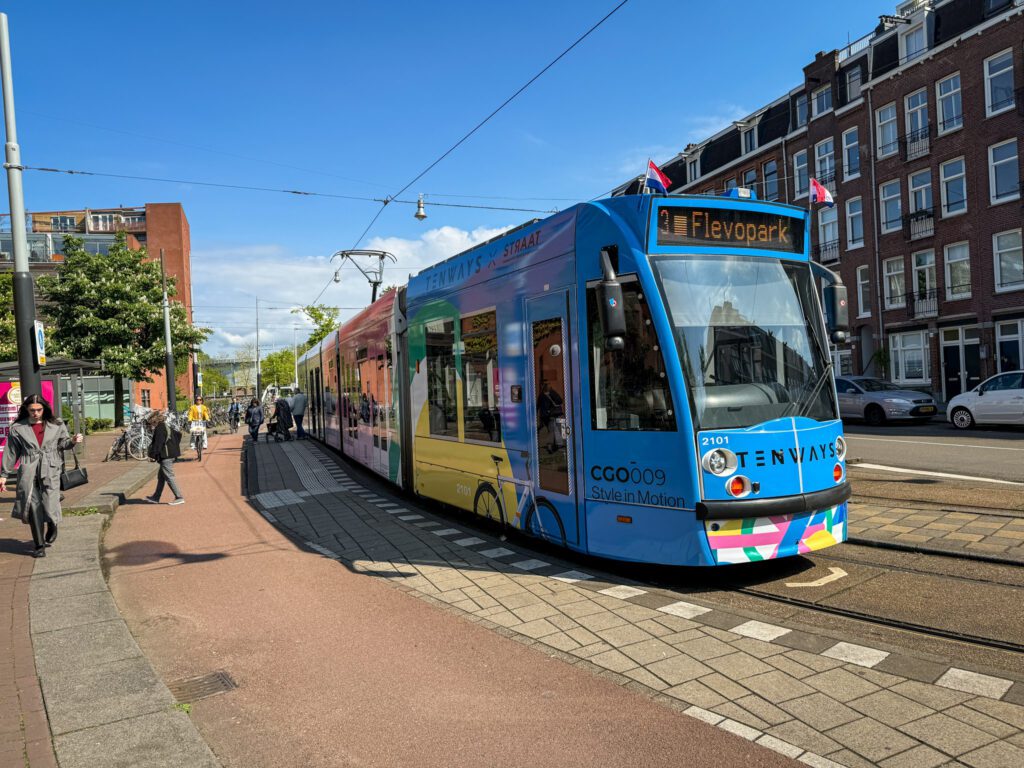
The best way to get around central Amsterdam is on your own two feet.
Oftentimes our favorite memories of Amsterdam are centered around early morning or late evening walks along the canals, when they are blissfully empty of the throngs of tourists that descend on them during the day.
However, given limited time, there’s a solid chance that you’re going to want to get from point A to Point B a little faster than walking allows for, and the good news is that Amsterdam has an excellent network of public transportation options.
I’ve had numerous Europeans – British, French, and now Dutch – make fun of me when my answer to “what’s your favorite thing about X country” is something along the lines of “the public transportation.”
It’s so nice to have an option for getting around a city that is reliable, safe, clean, and convenient (meaning it comes more than once an hour), which is something that the vast majority of cities in the U.S. don’t have.
There are basically three forms of public transportation within Amsterdam – the trams (which are the best option because they avoid traffic), the buses, and the metro (which is underground and has a more limited network).
In terms of tickets, you can either tap your credit or debit card when you board (and, crucially, when you exit – you need to tap on and off in Amsterdam) or buy a 24, 48, or 72 hour pass that covers the buses, metro, and trams.
Given the fact that each ride costs €3.40, and a 48 Hour Pass costs €15 (with the bus from the airport it’s €24) it probably makes sense to just bite the bullet and get a pass when you arrive to give you maximum flexibility as you’re exploring.
The best place to buy it is going to be at the airport when you arrive (or the train station when you arrive), especially considering that there is a version of the pass that covers the bus ride from the airport to the city (if you take Bus 397, which I did multiple times).
More information on public transportation in Amsterdam here.
More Amsterdam Travel Guides
Planning a trip to Amsterdam? We’ve been to Amsterdam multiple times over the past few years (including a longer two week spring trip to Amsterdam).
That time spent allowed us to dive deeper into Amsterdam’s unique history and cultural elements that most people miss, like how the mercantilism in early Amsterdam influences the food scene today.
As you get into planning your trip, you might find some of these other detailed guides we’ve written about Amsterdam helpful.

I’m dying to visit Amsterdam and this post is what I needed to feel closer to that wonderful city!
I LOVE your site! Thank you for this comprehensive and helpful itinerary!
I and2 friends have 2 days in Amsterdam in September so your article was very interesting and hopefully helpful. Also my son lives in Portland ( great city). I live in Ontario, Canada.
Glad to hear you found it helpful! Obviously we agree about Portland being a great city, and have Toronto on our future travel wishlist (for the food – apparently it’s a great place to eat gluten free – and the coffee scene). Cheers!